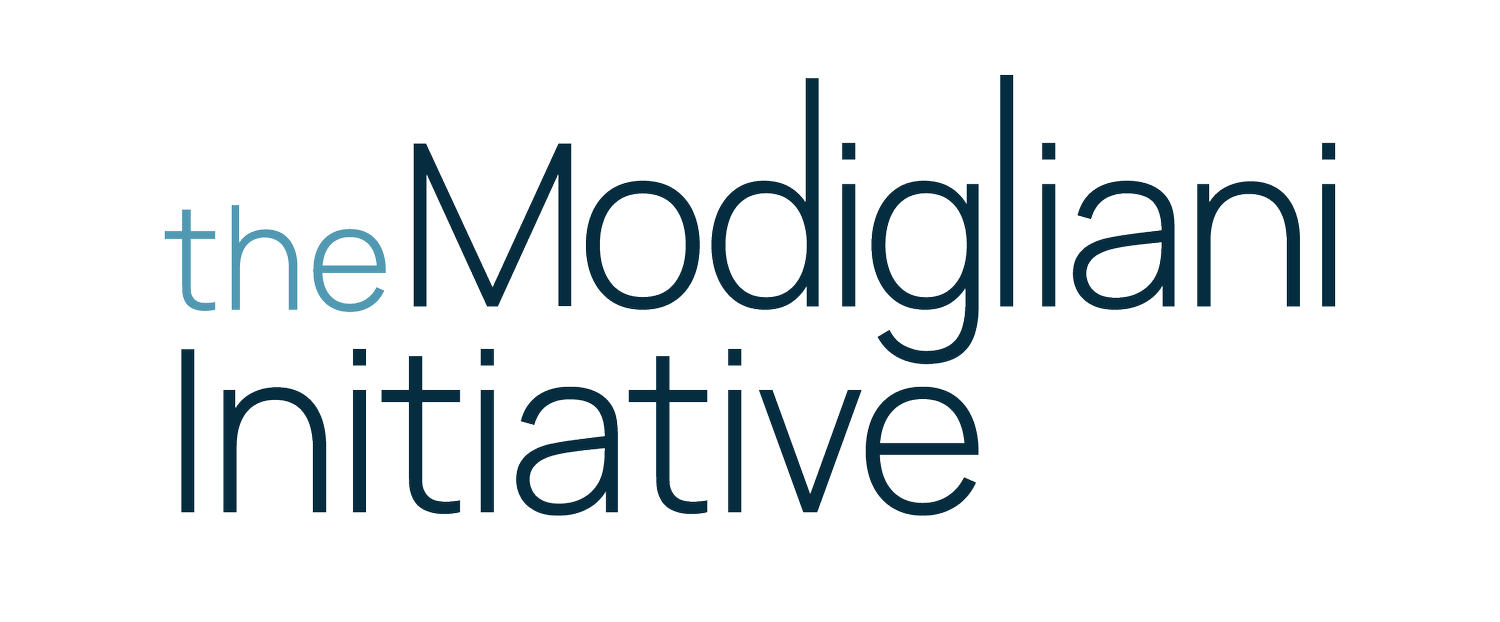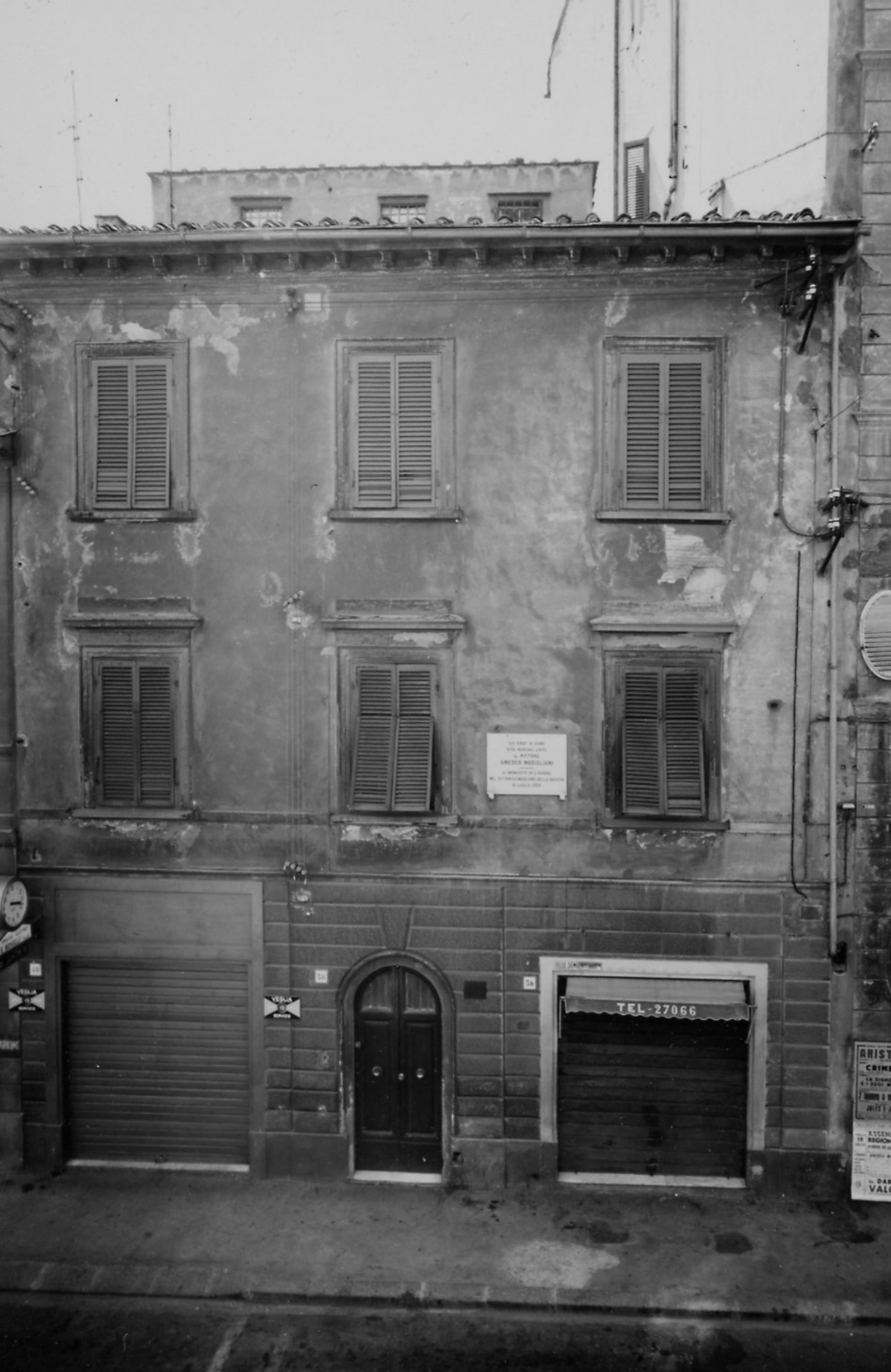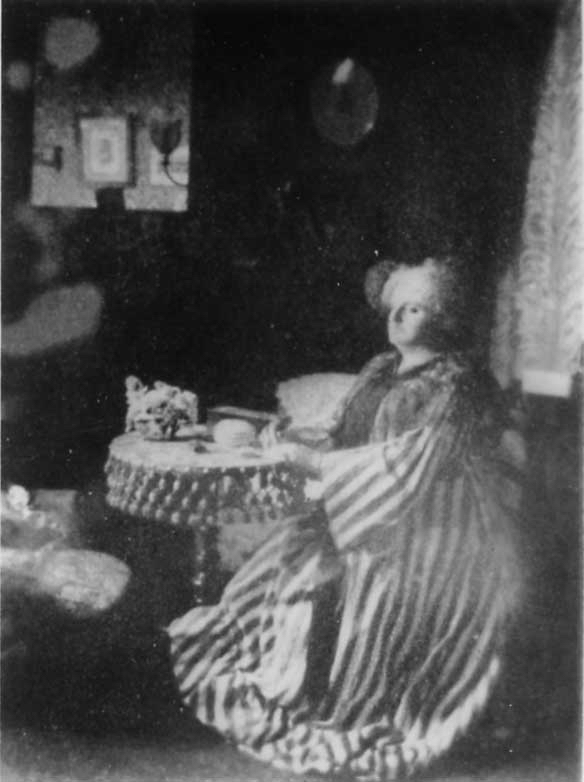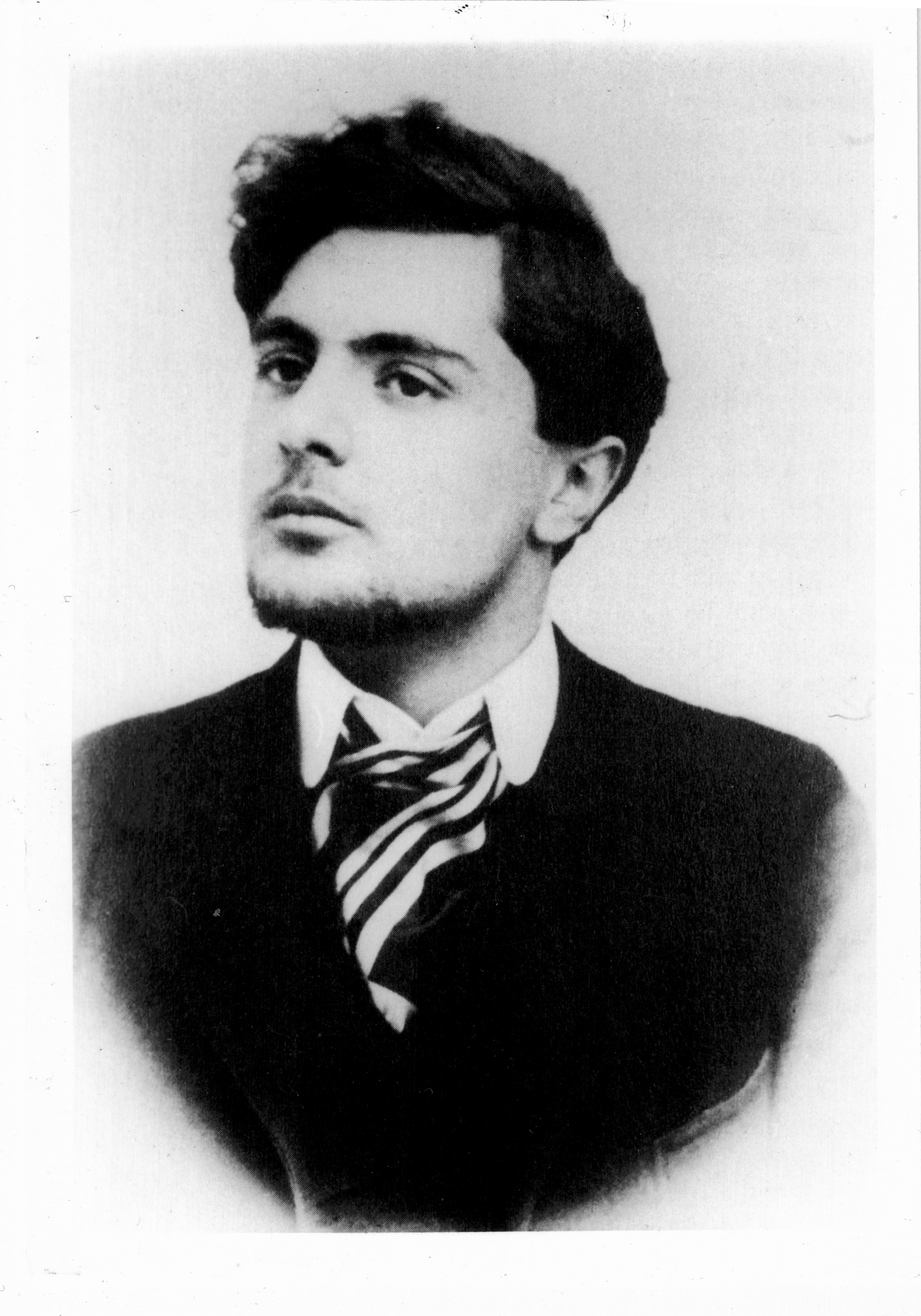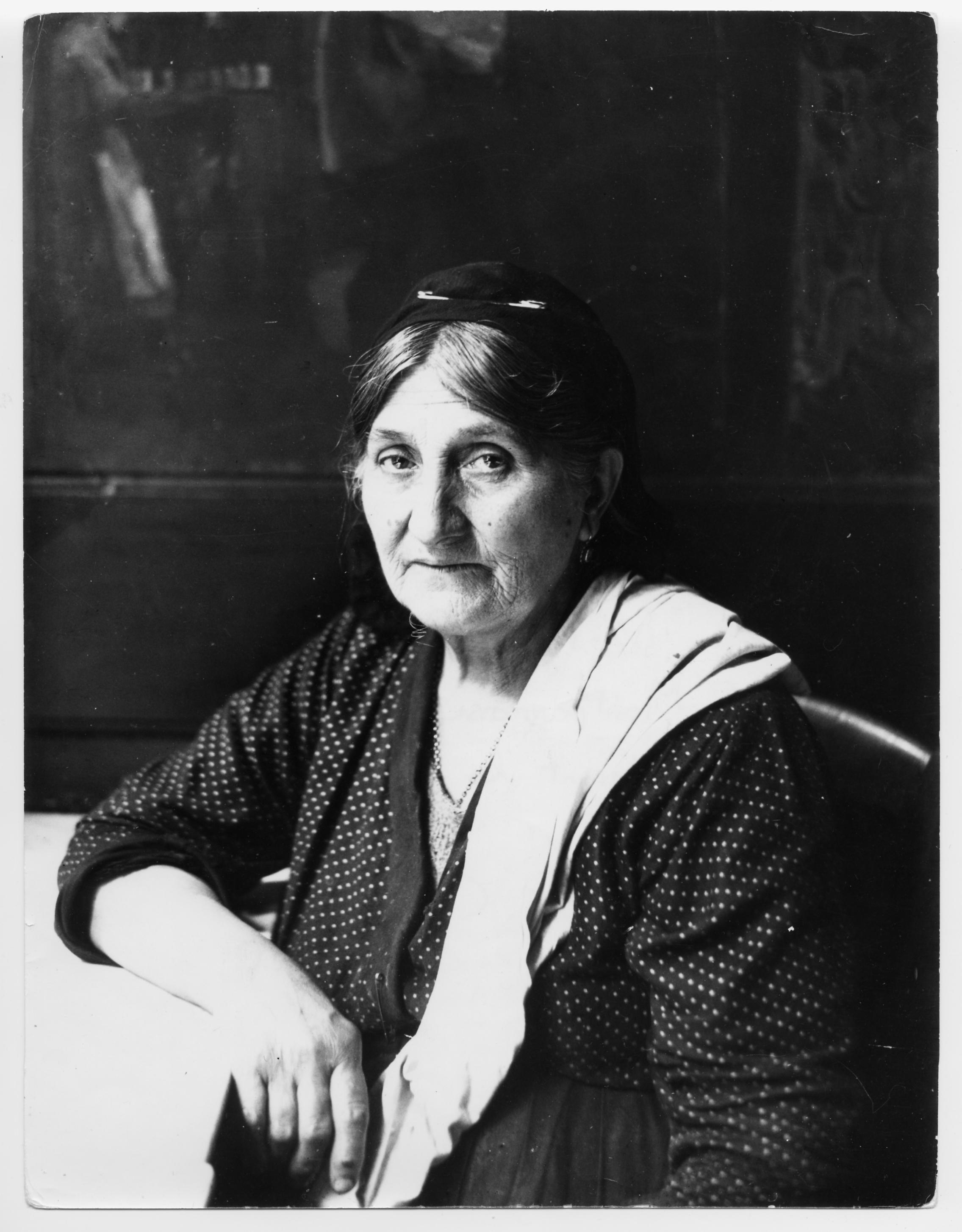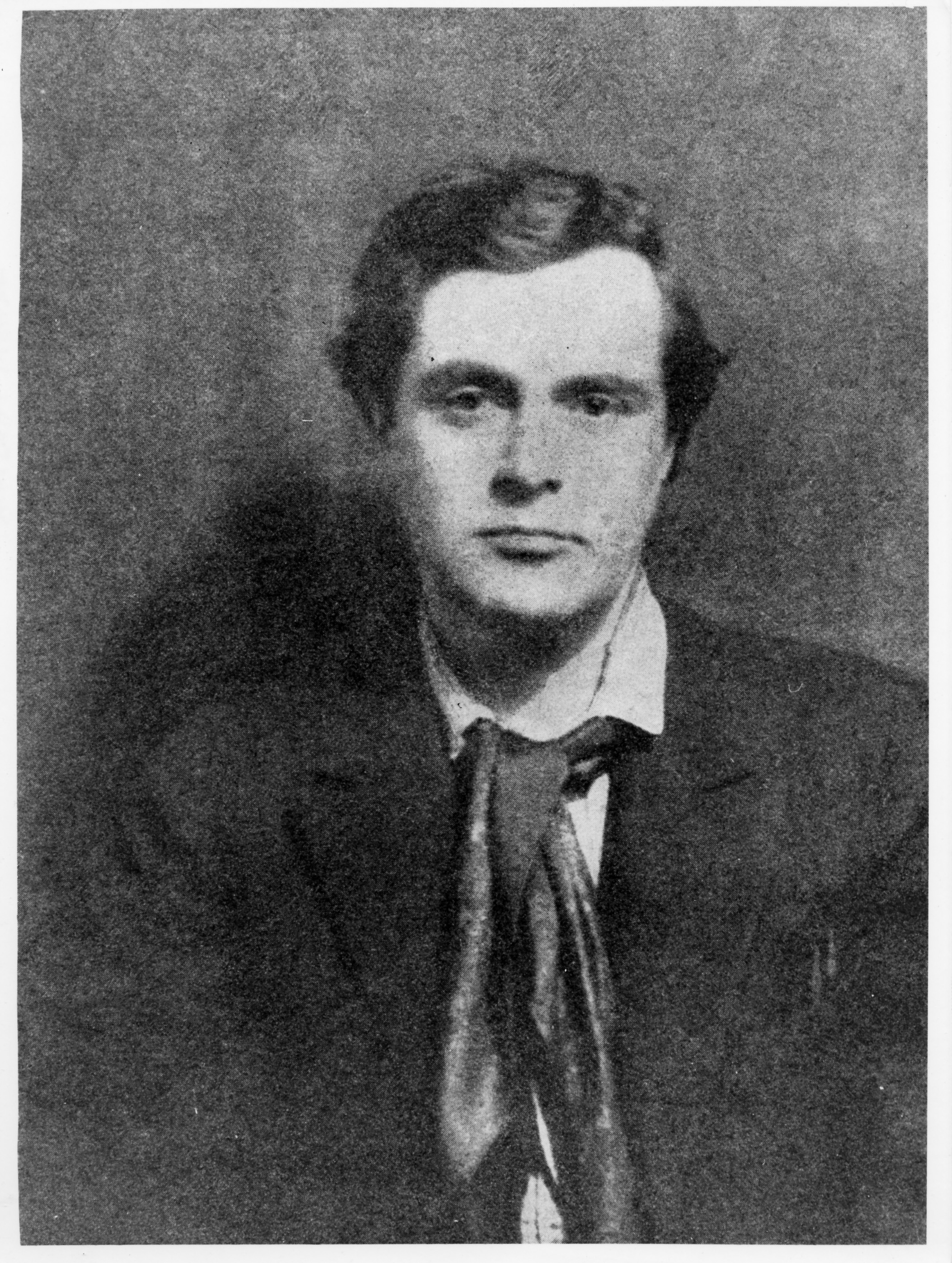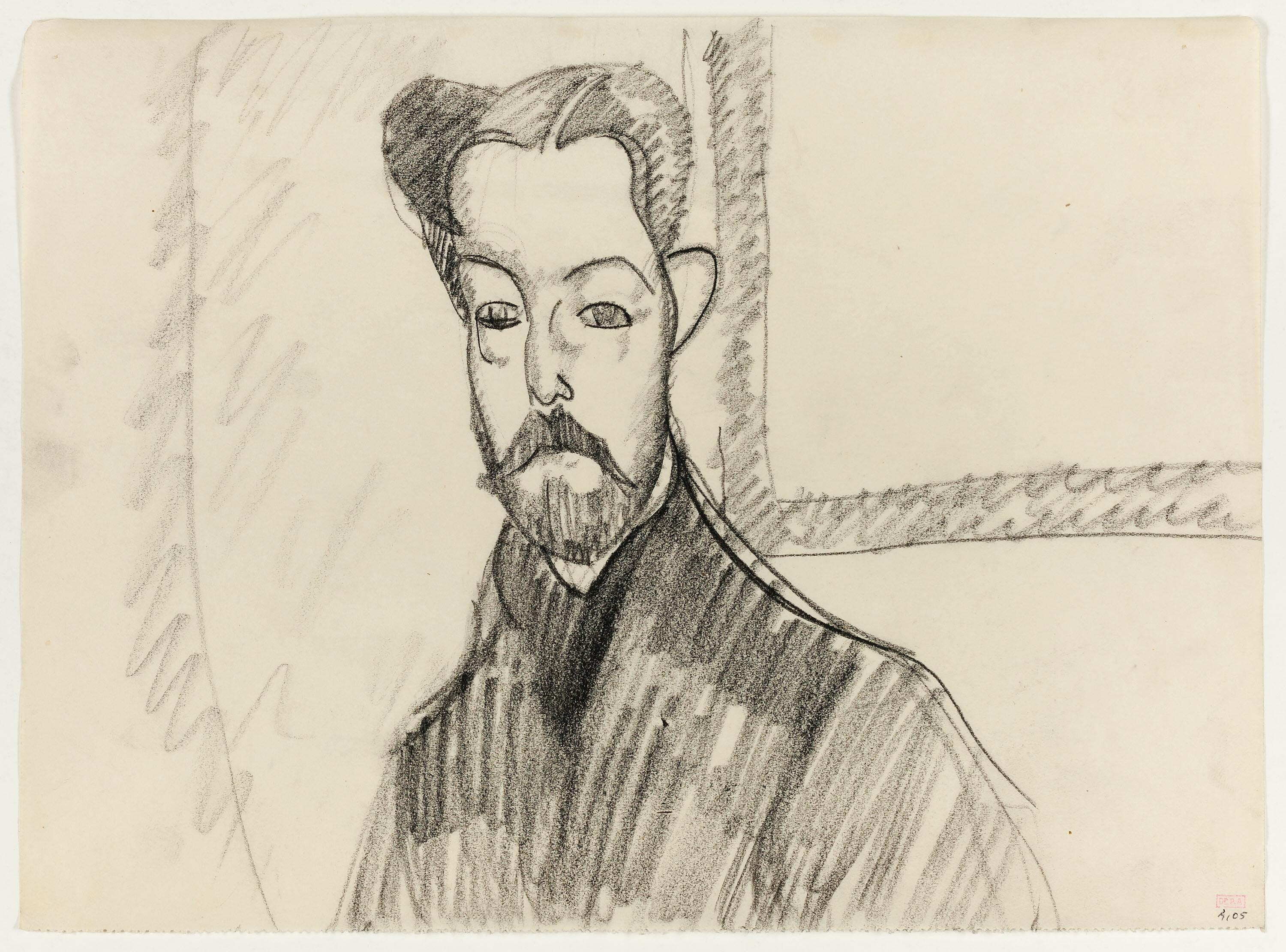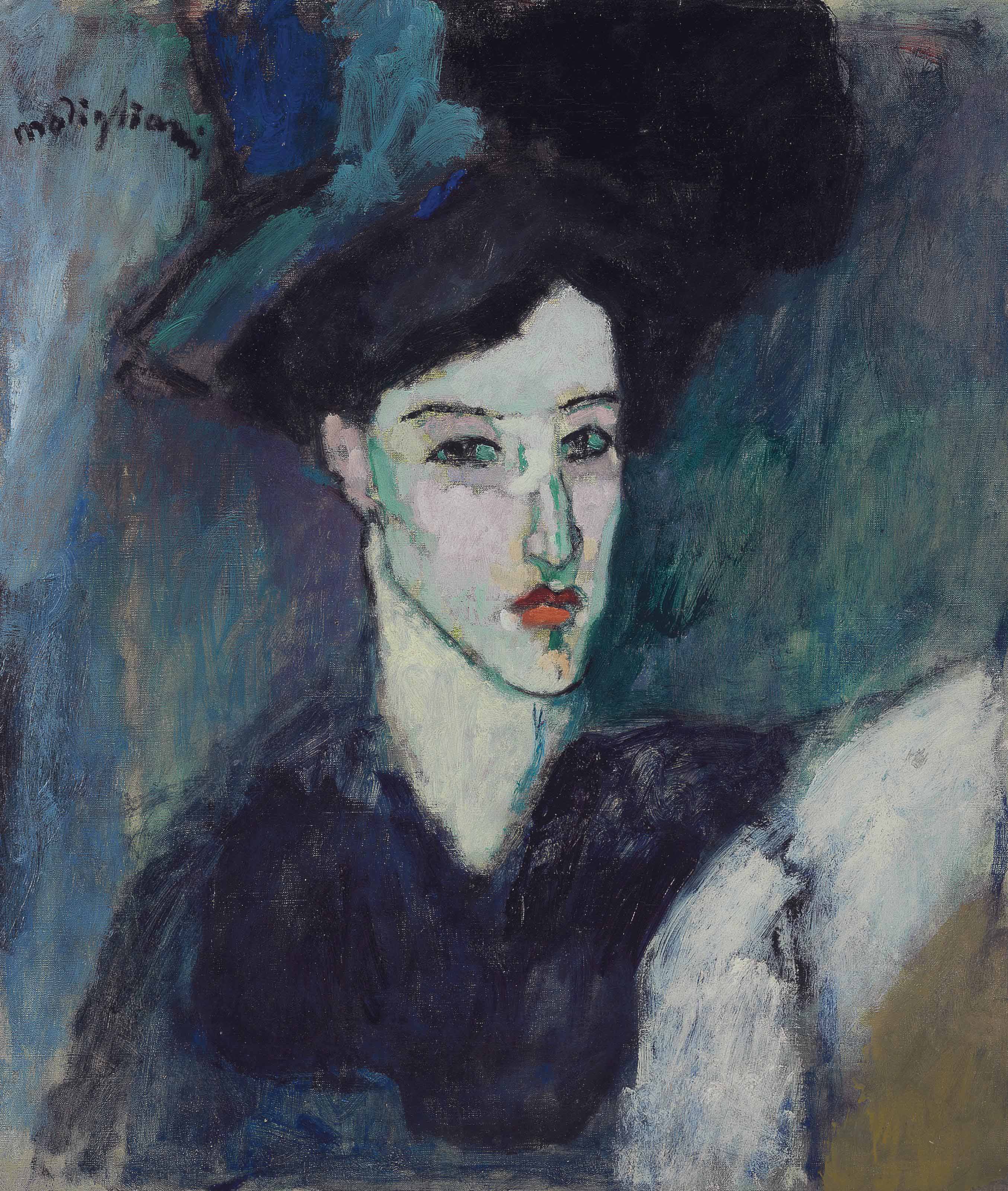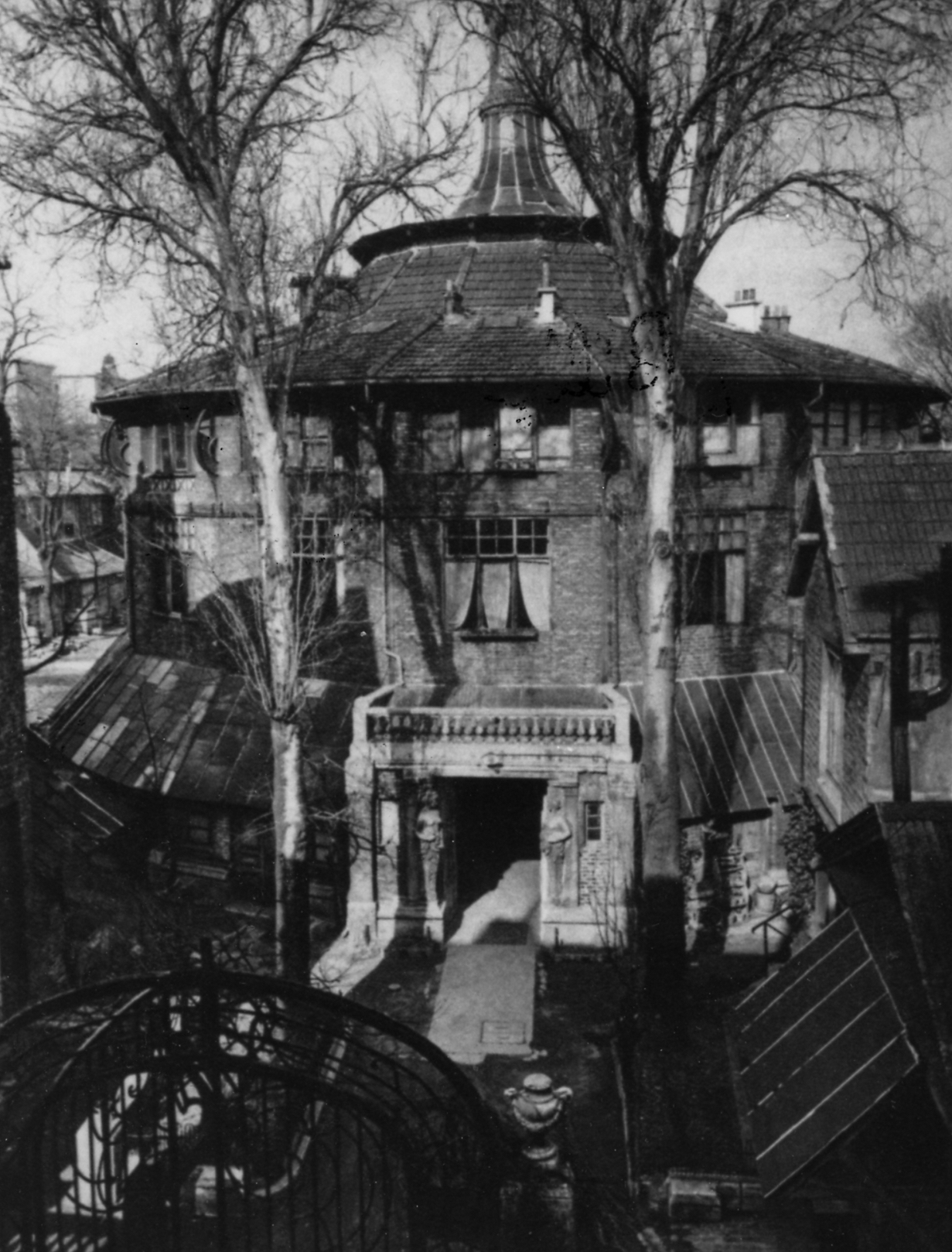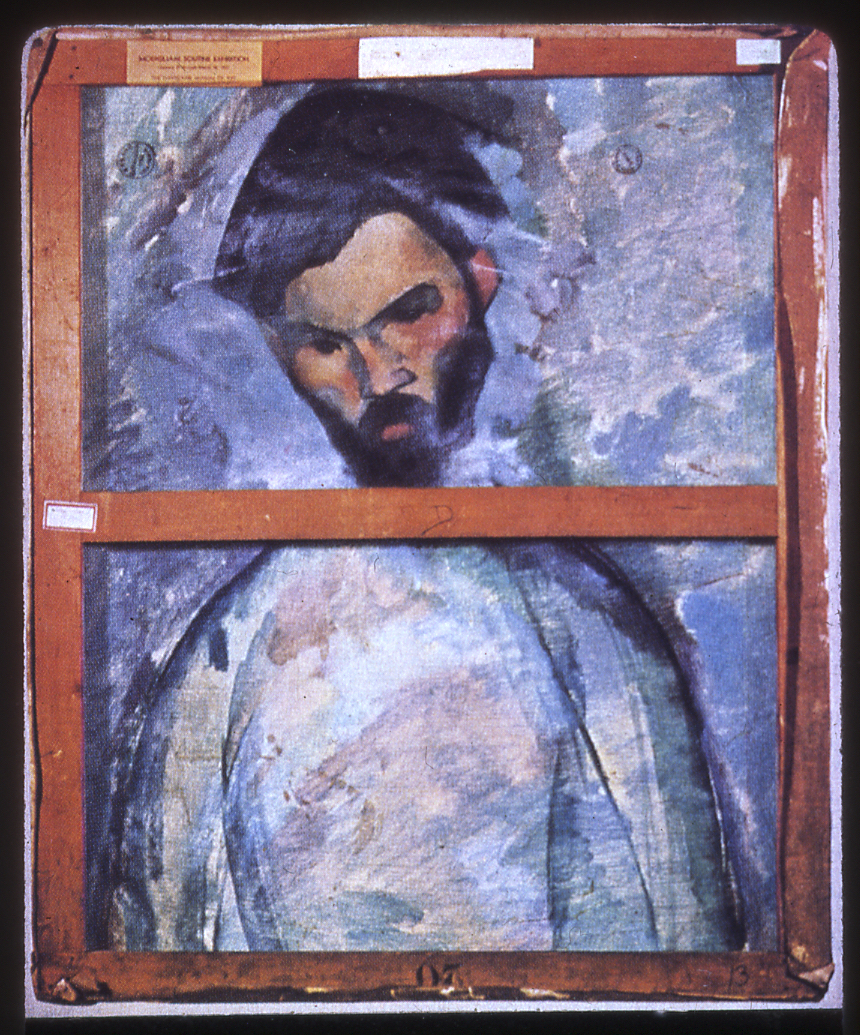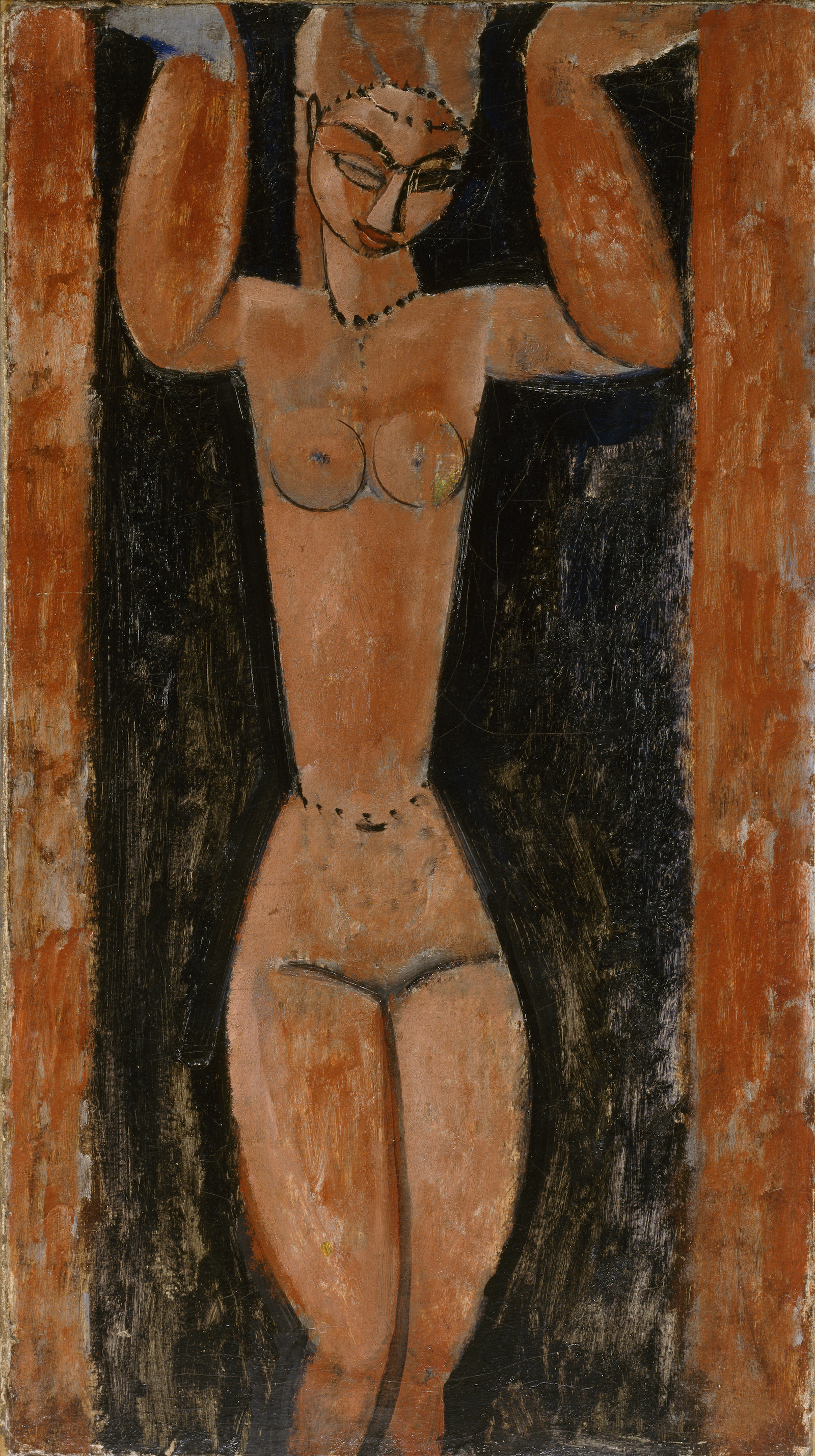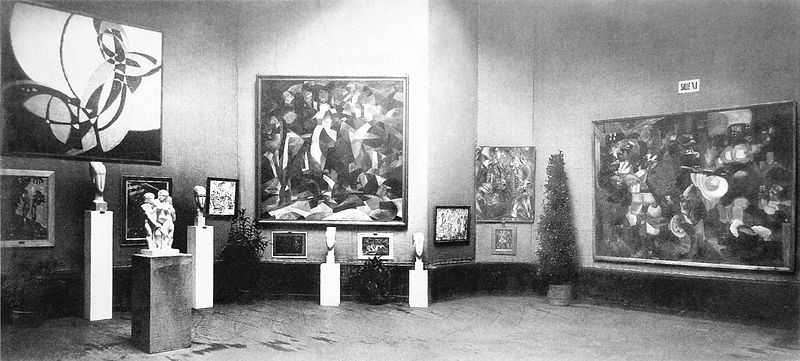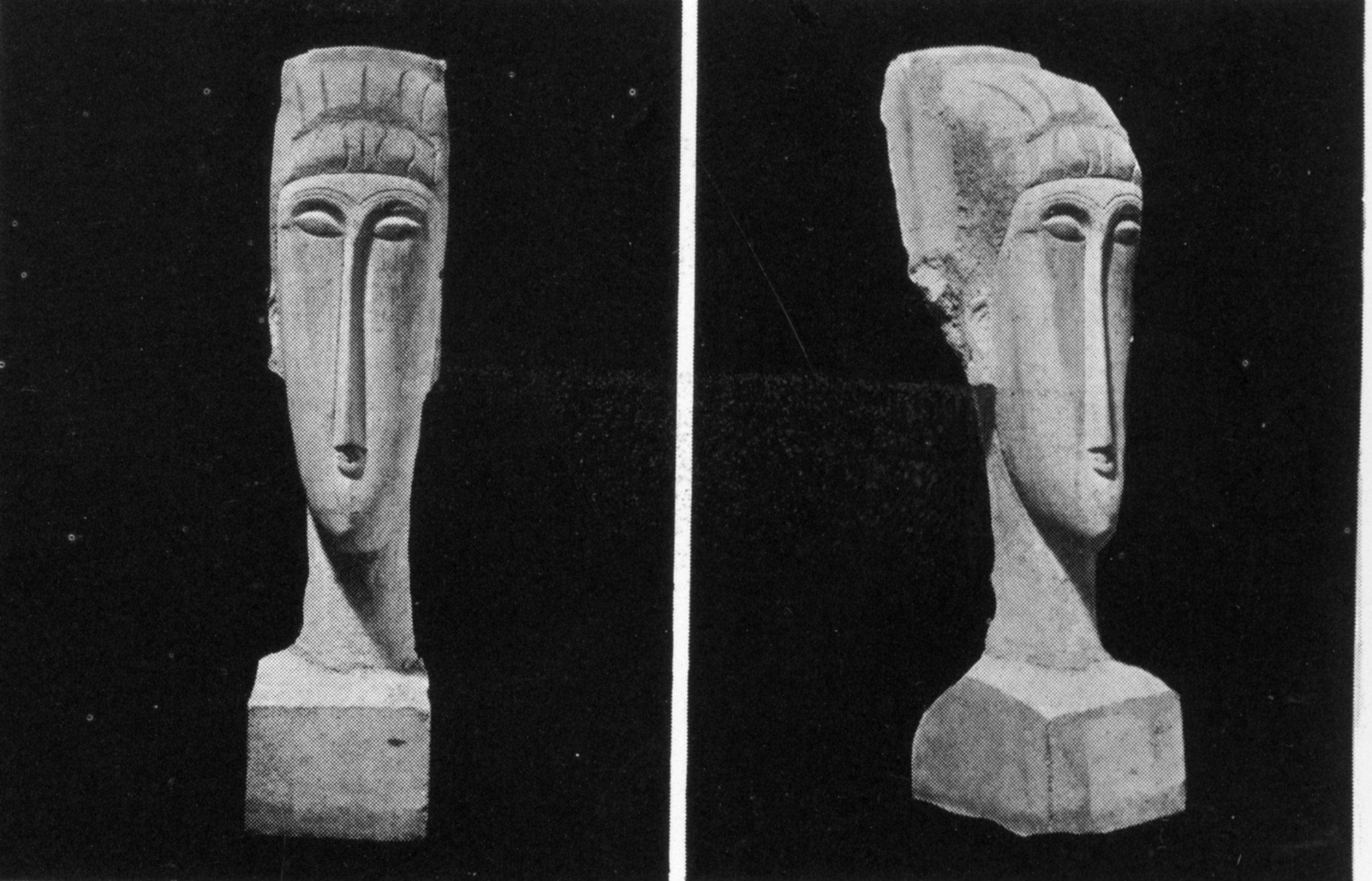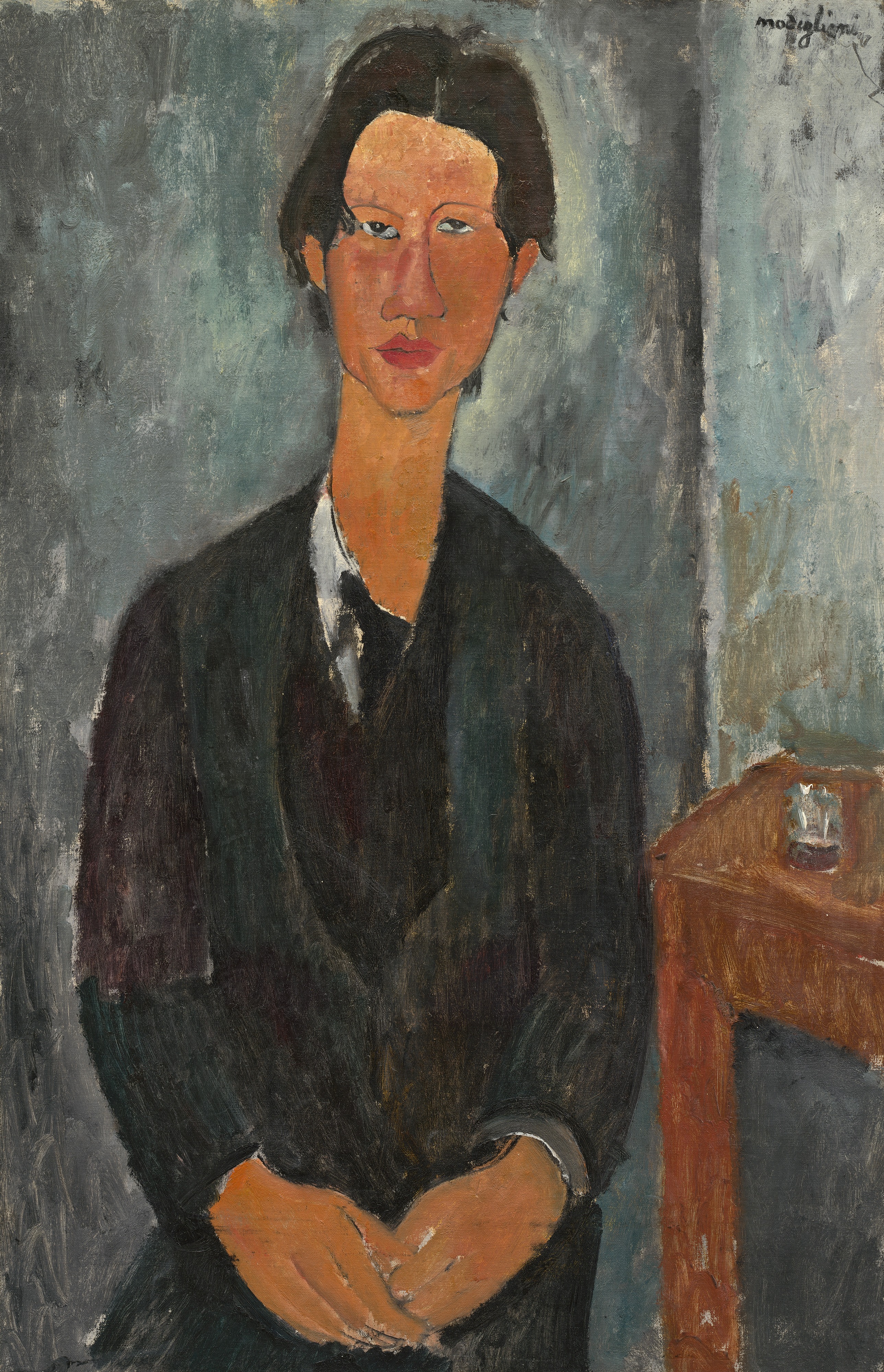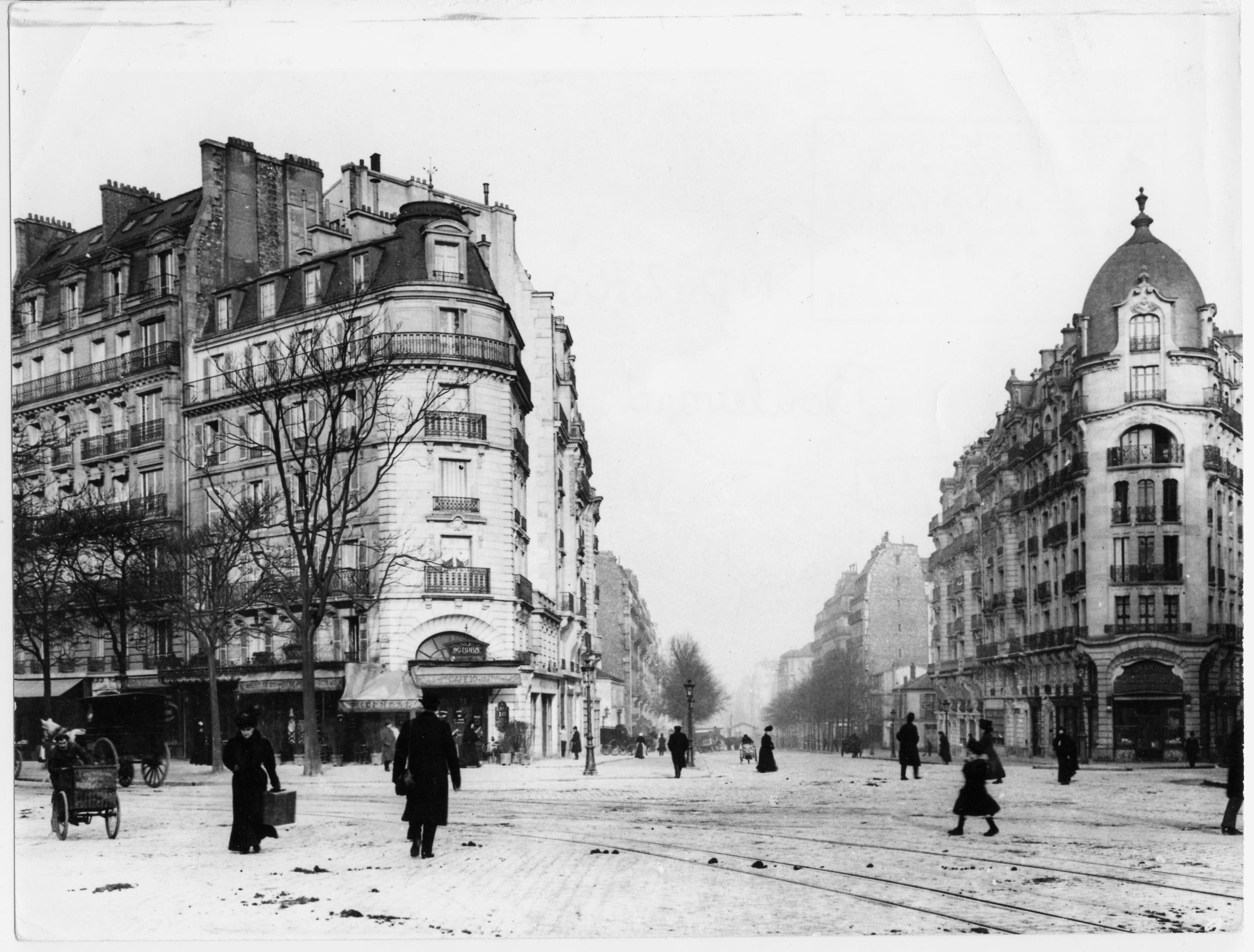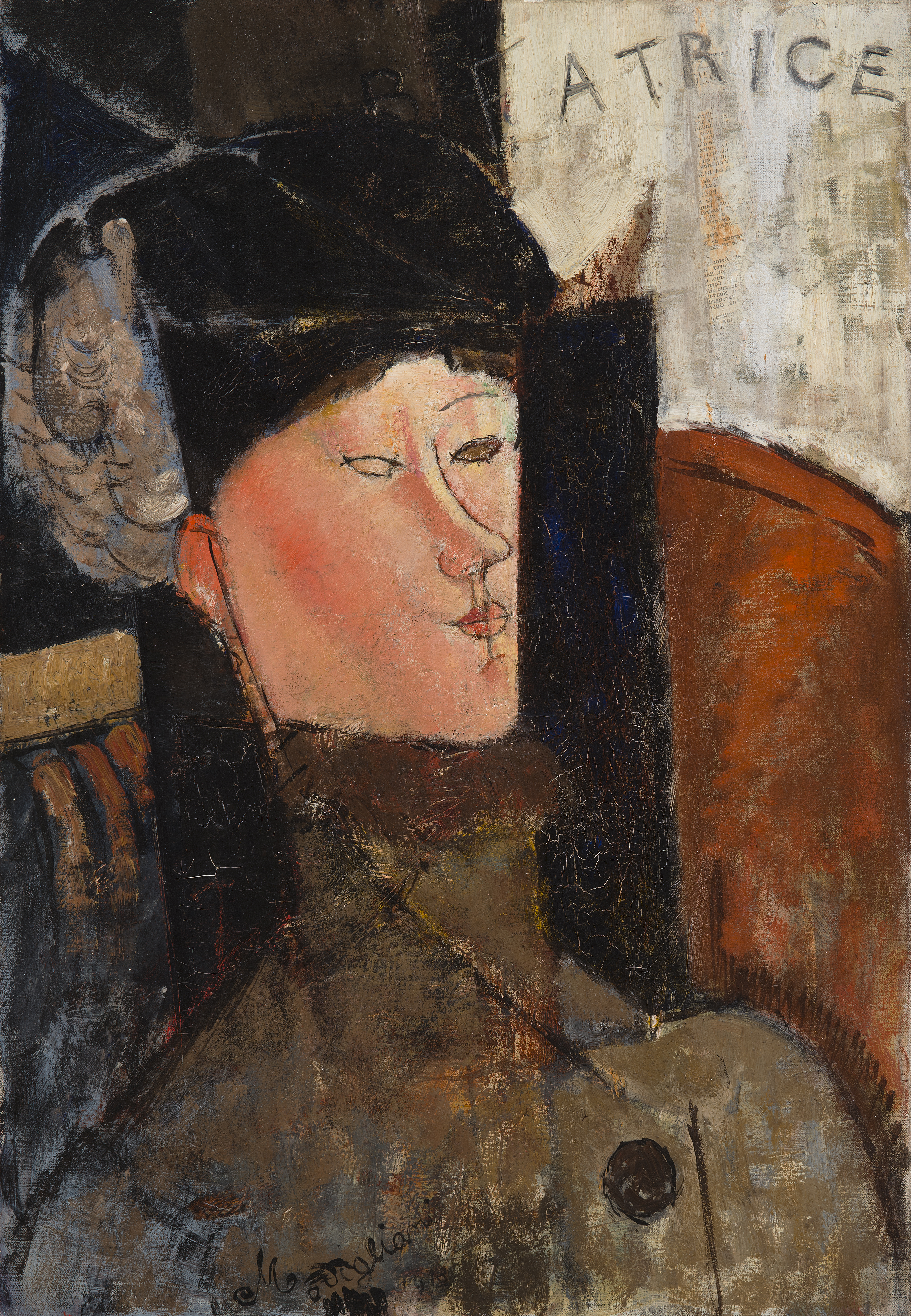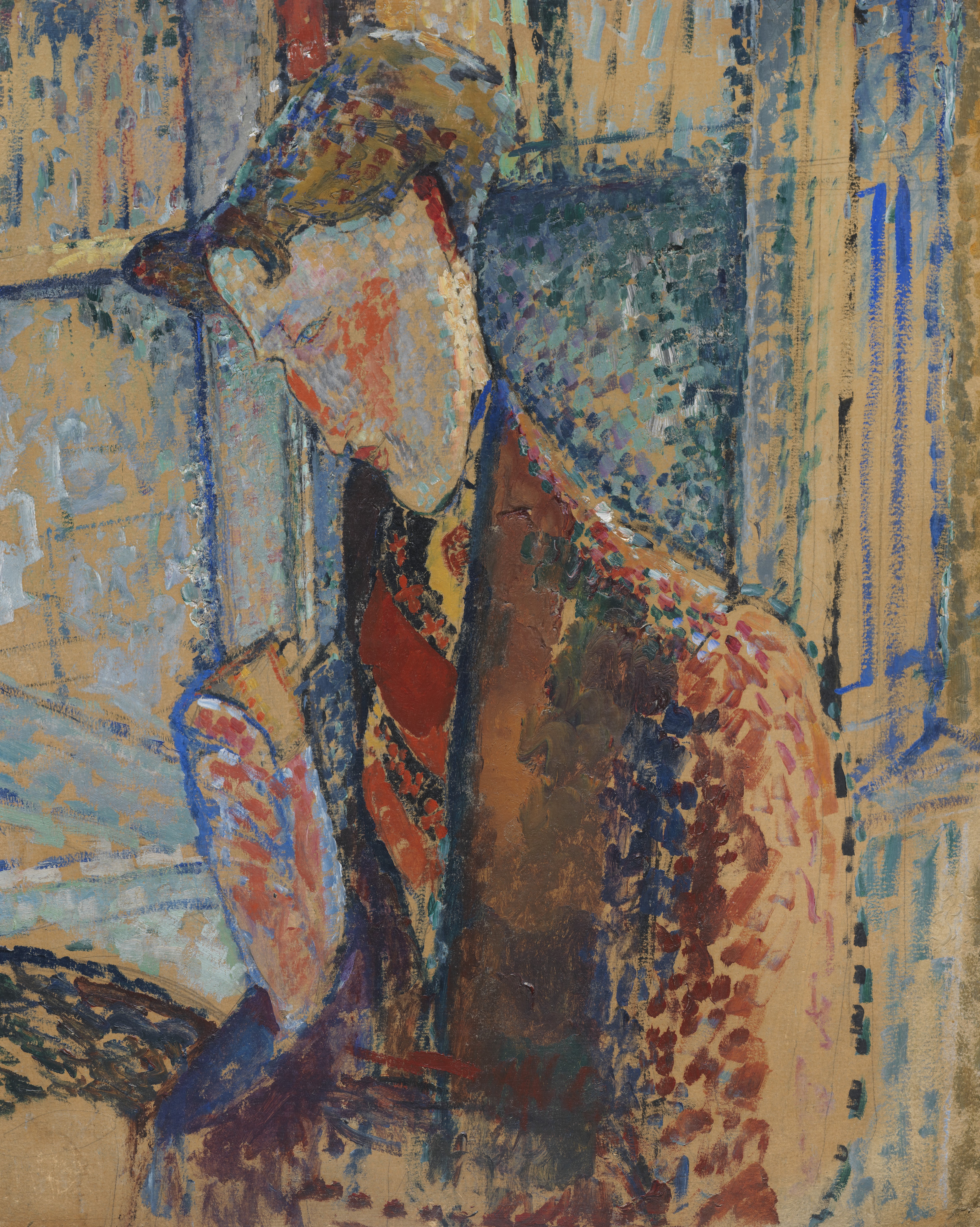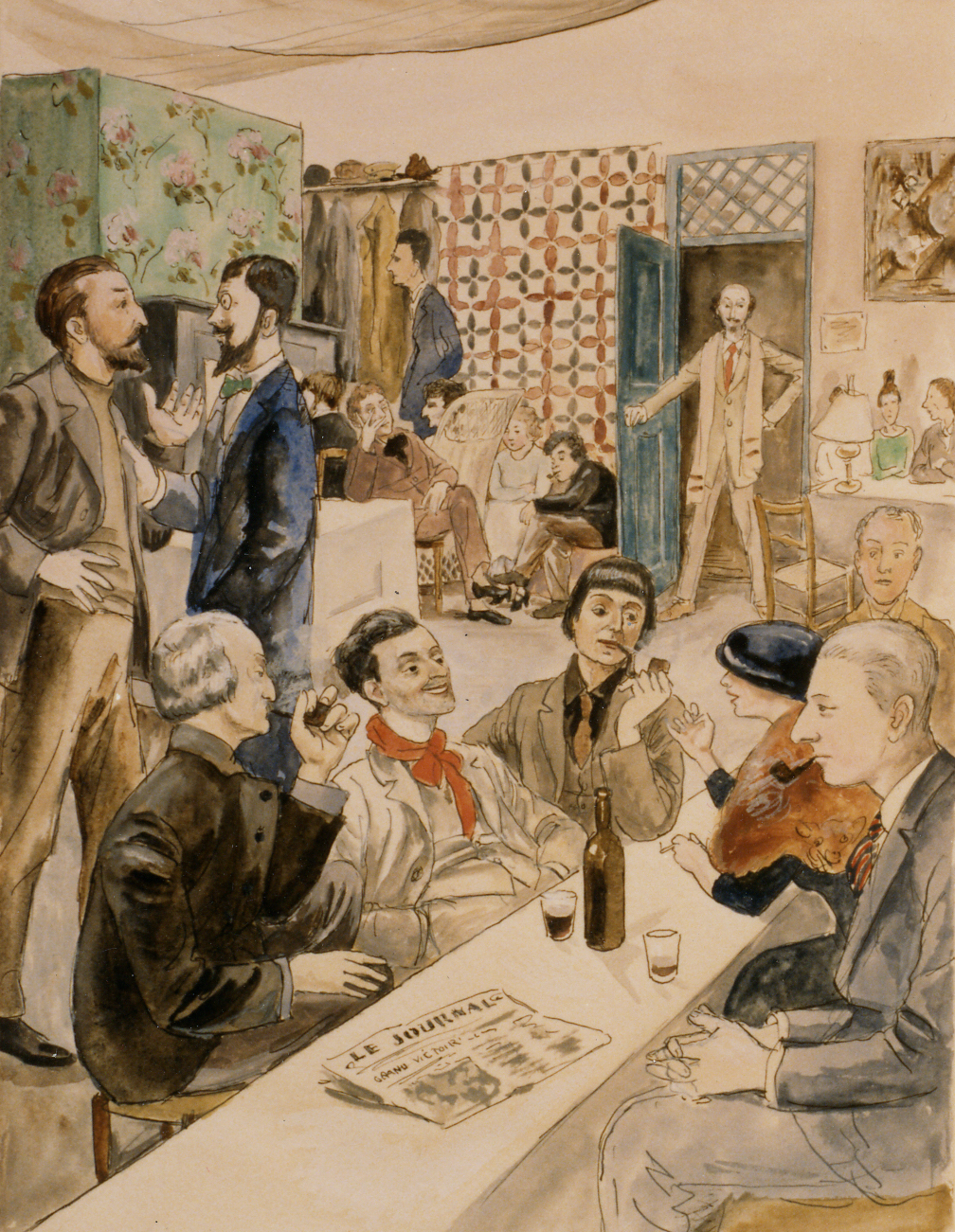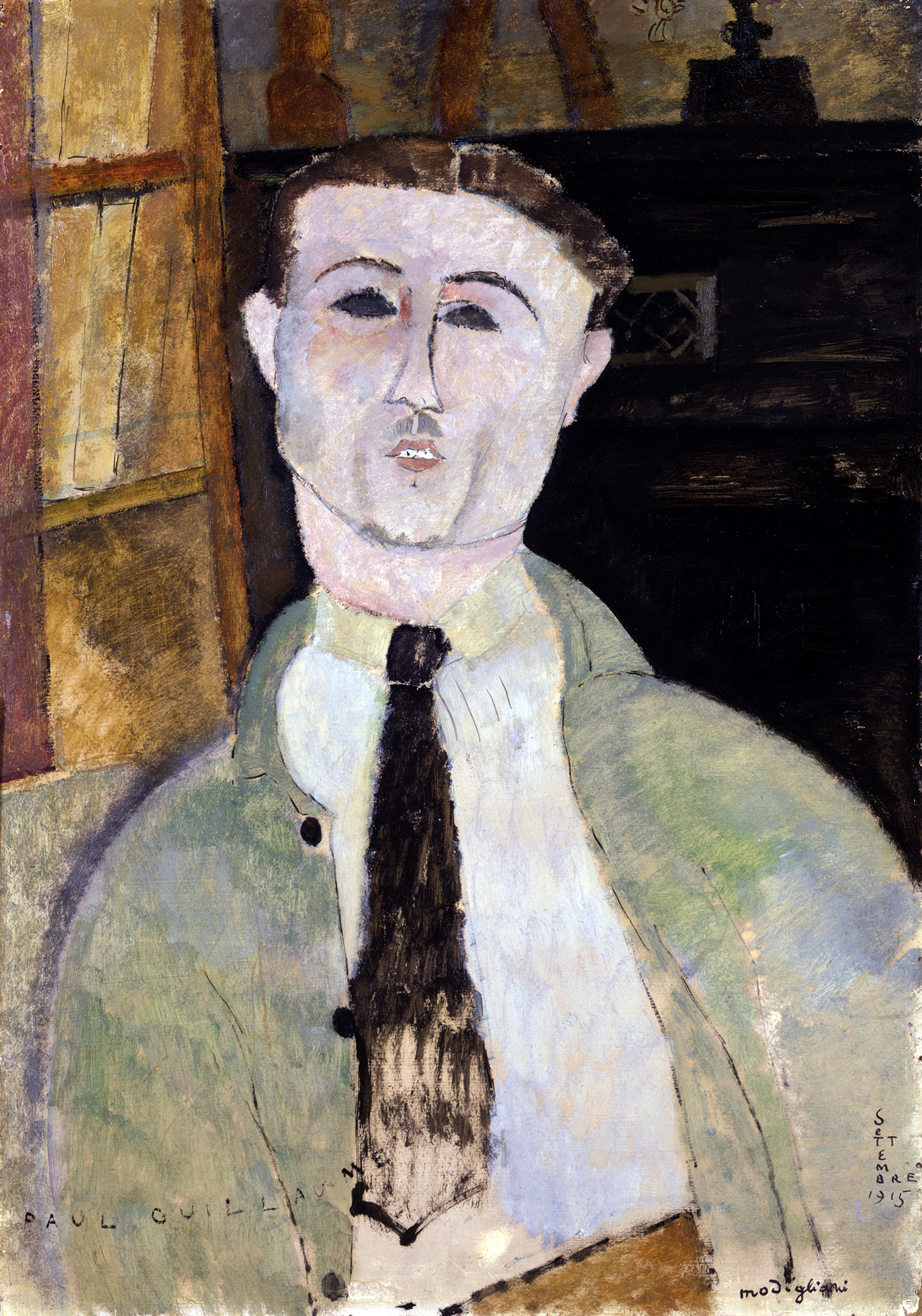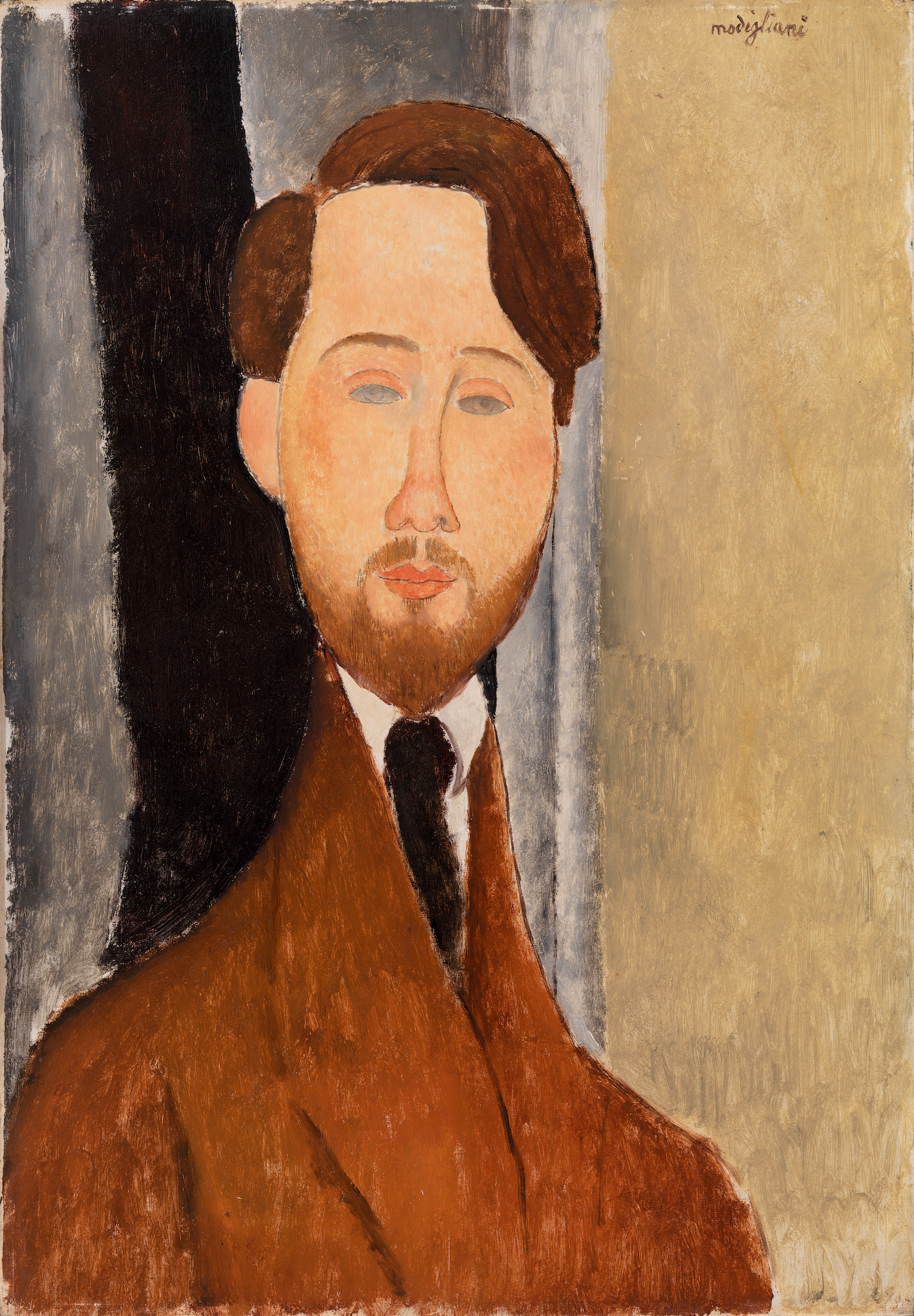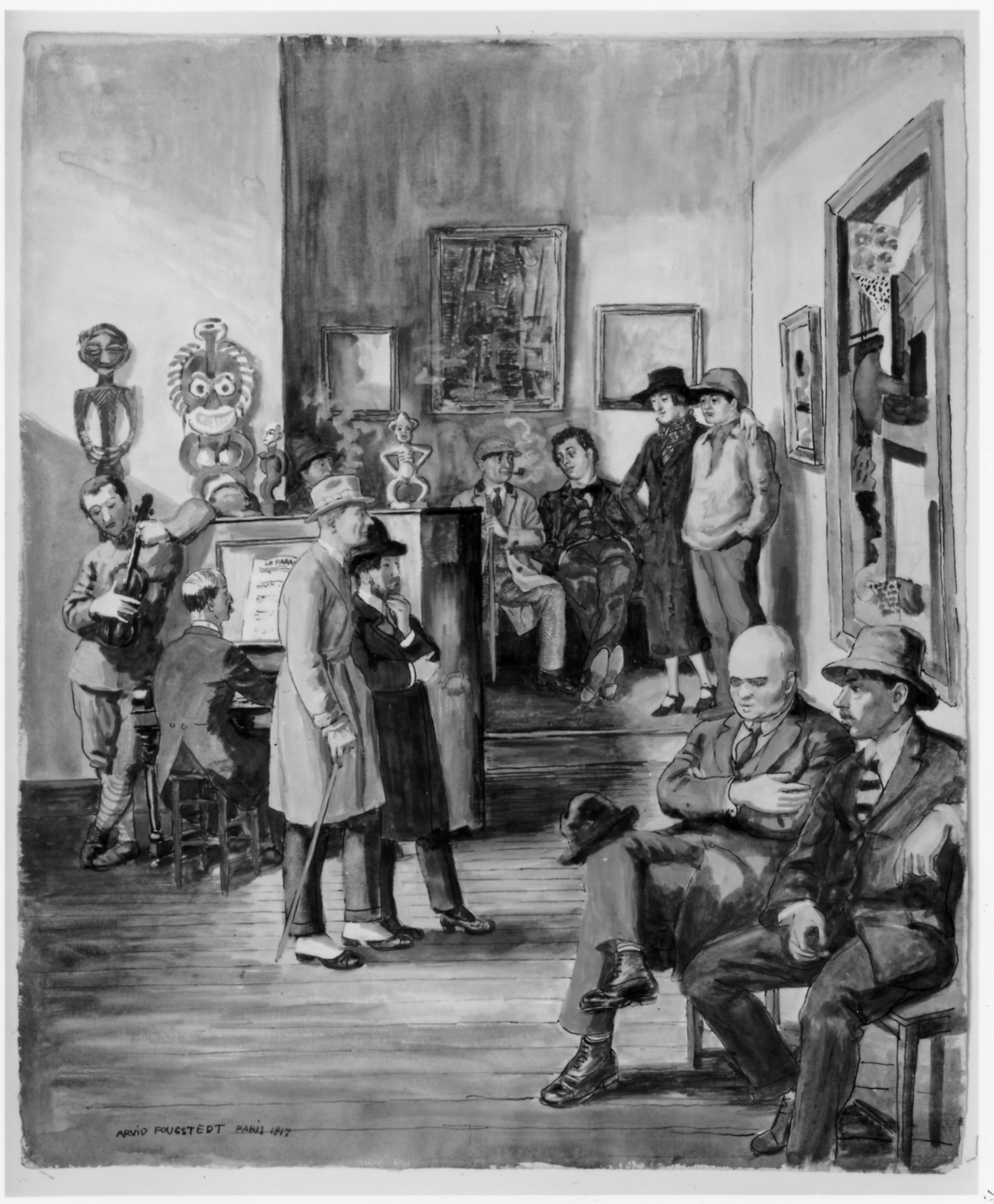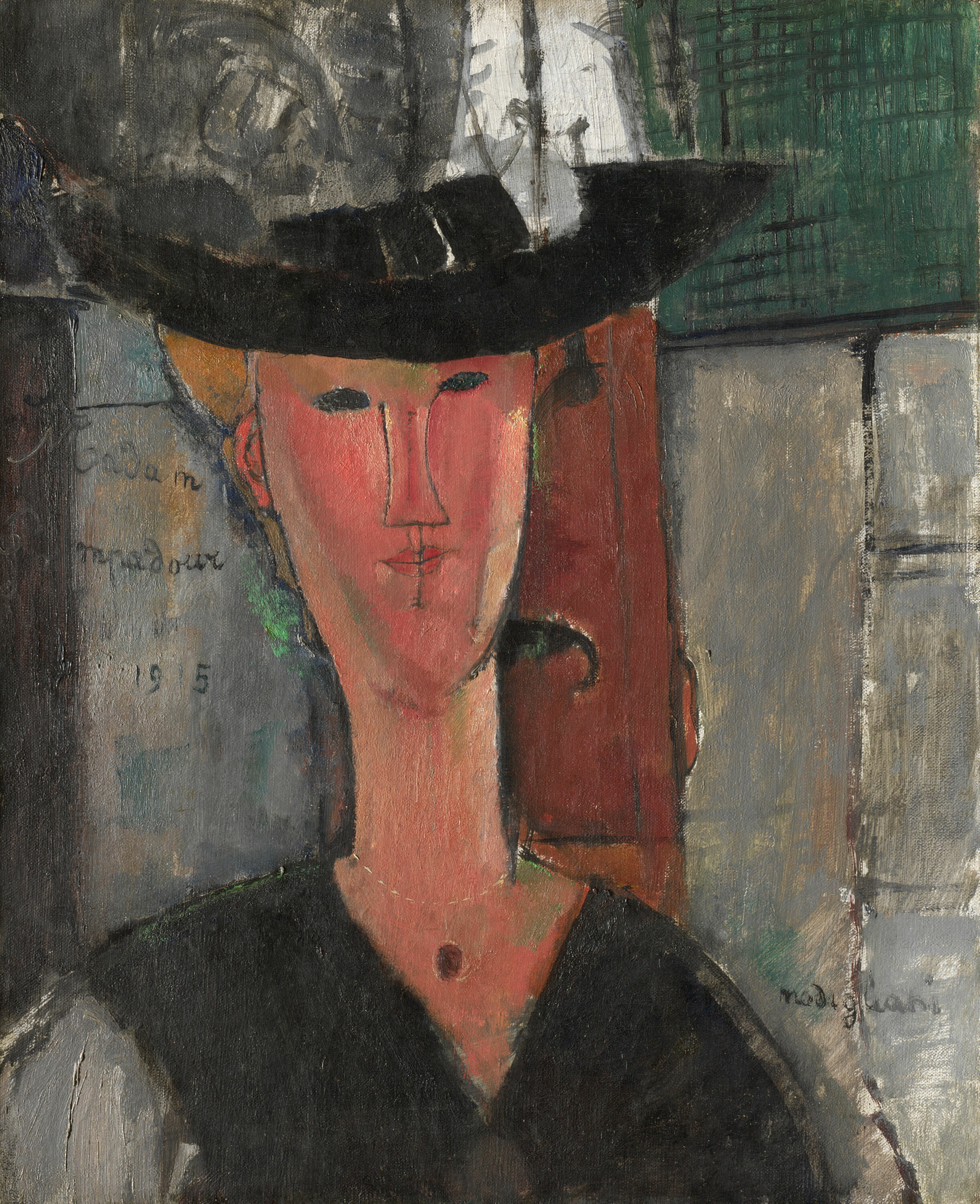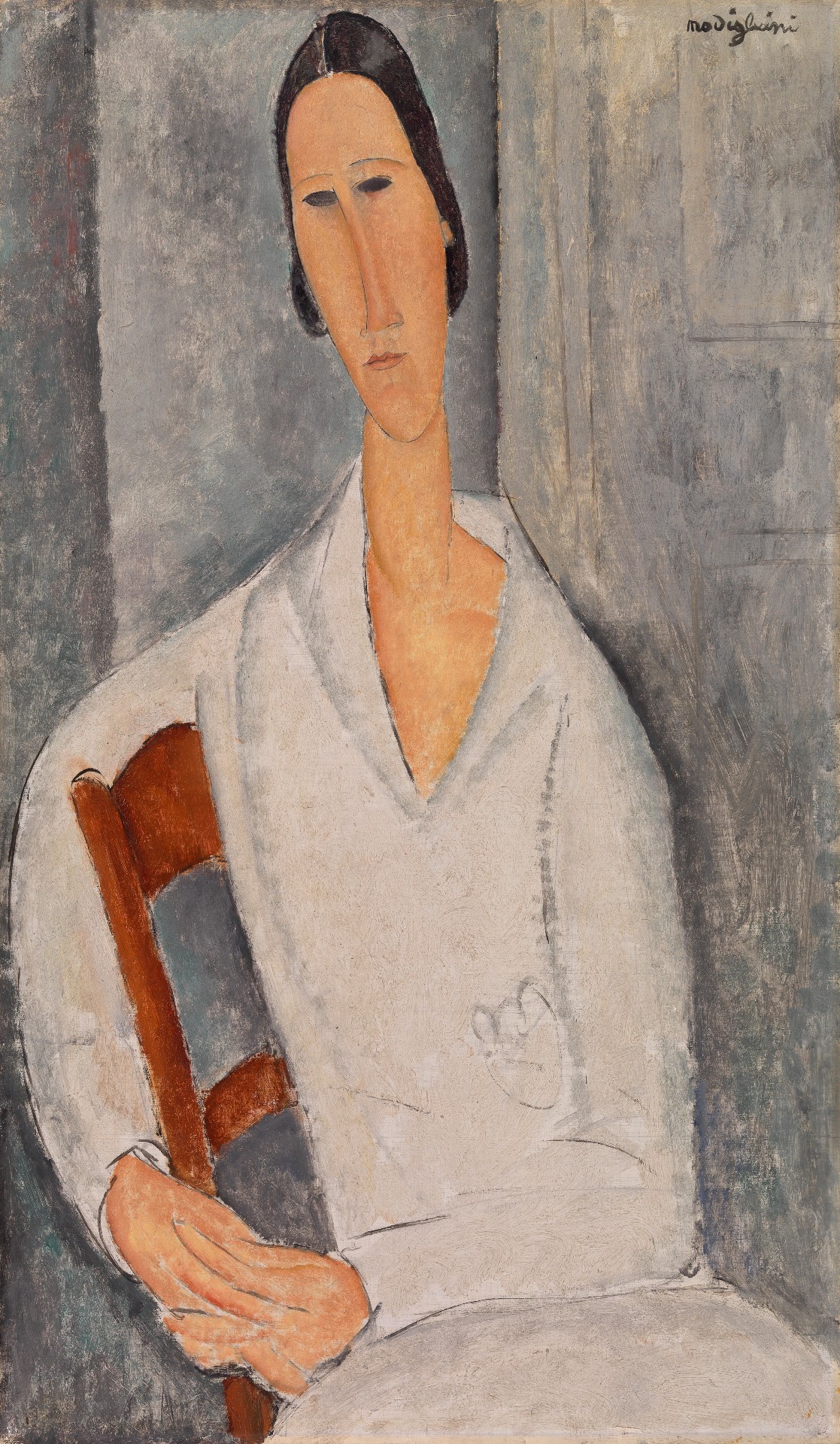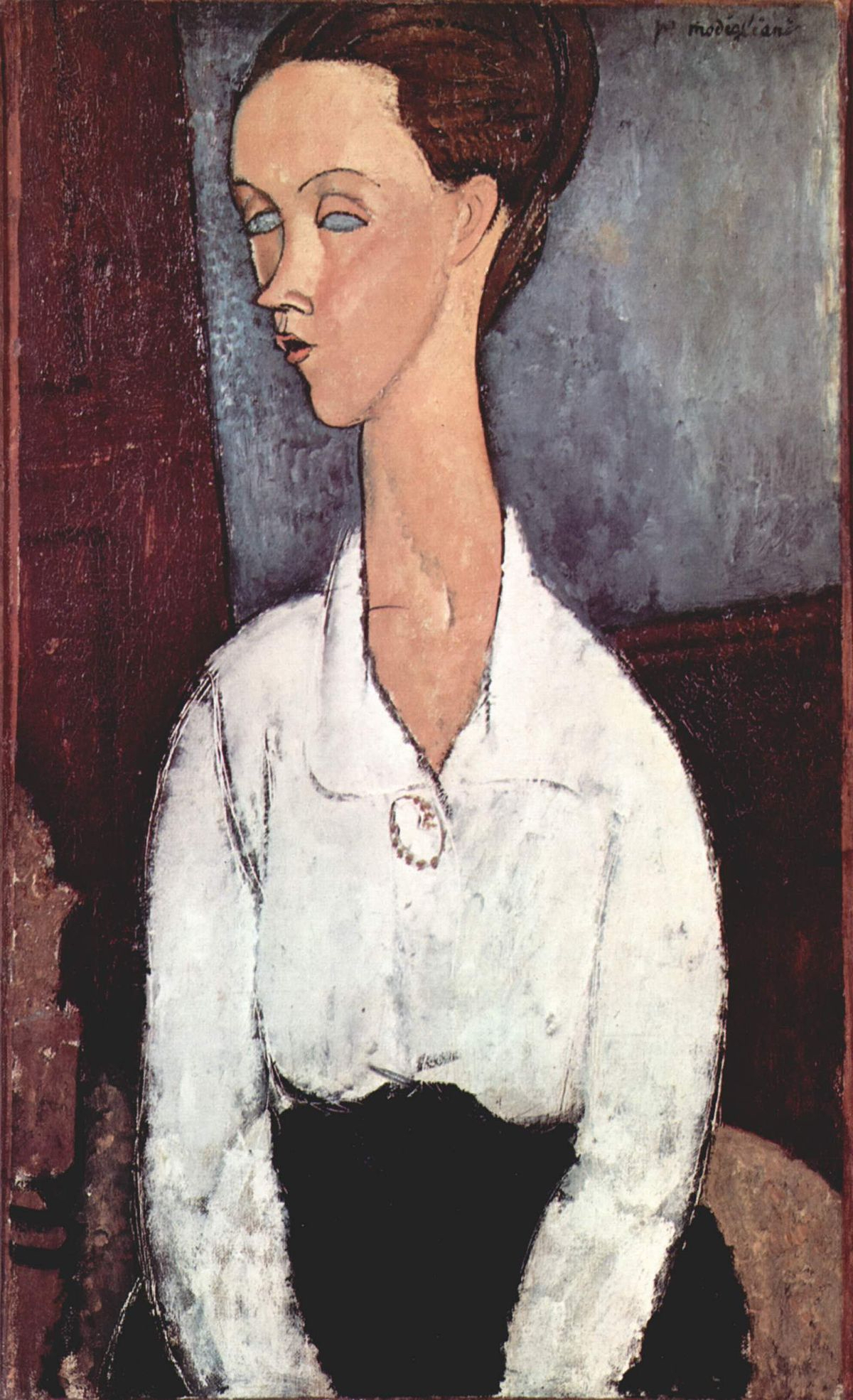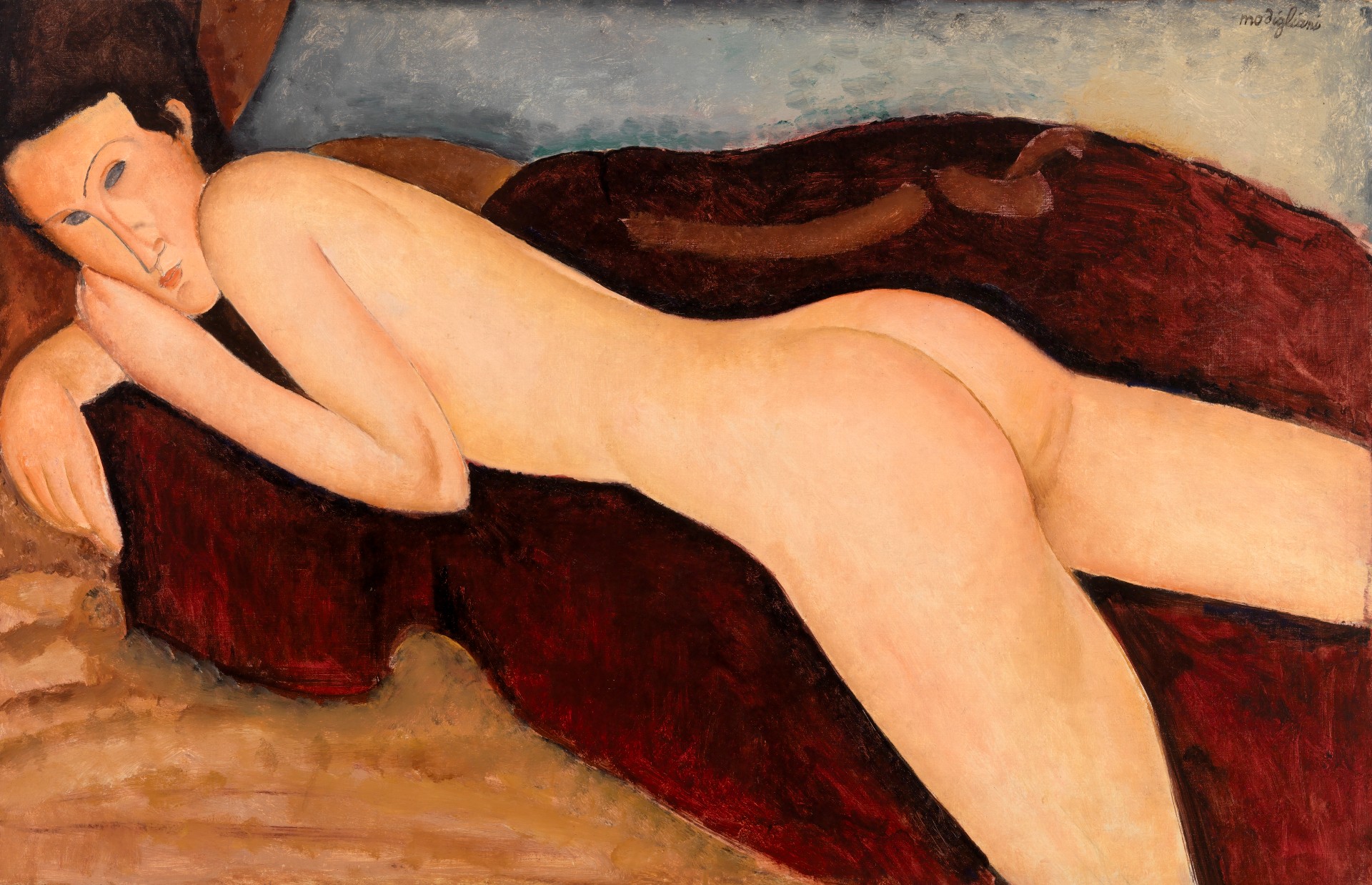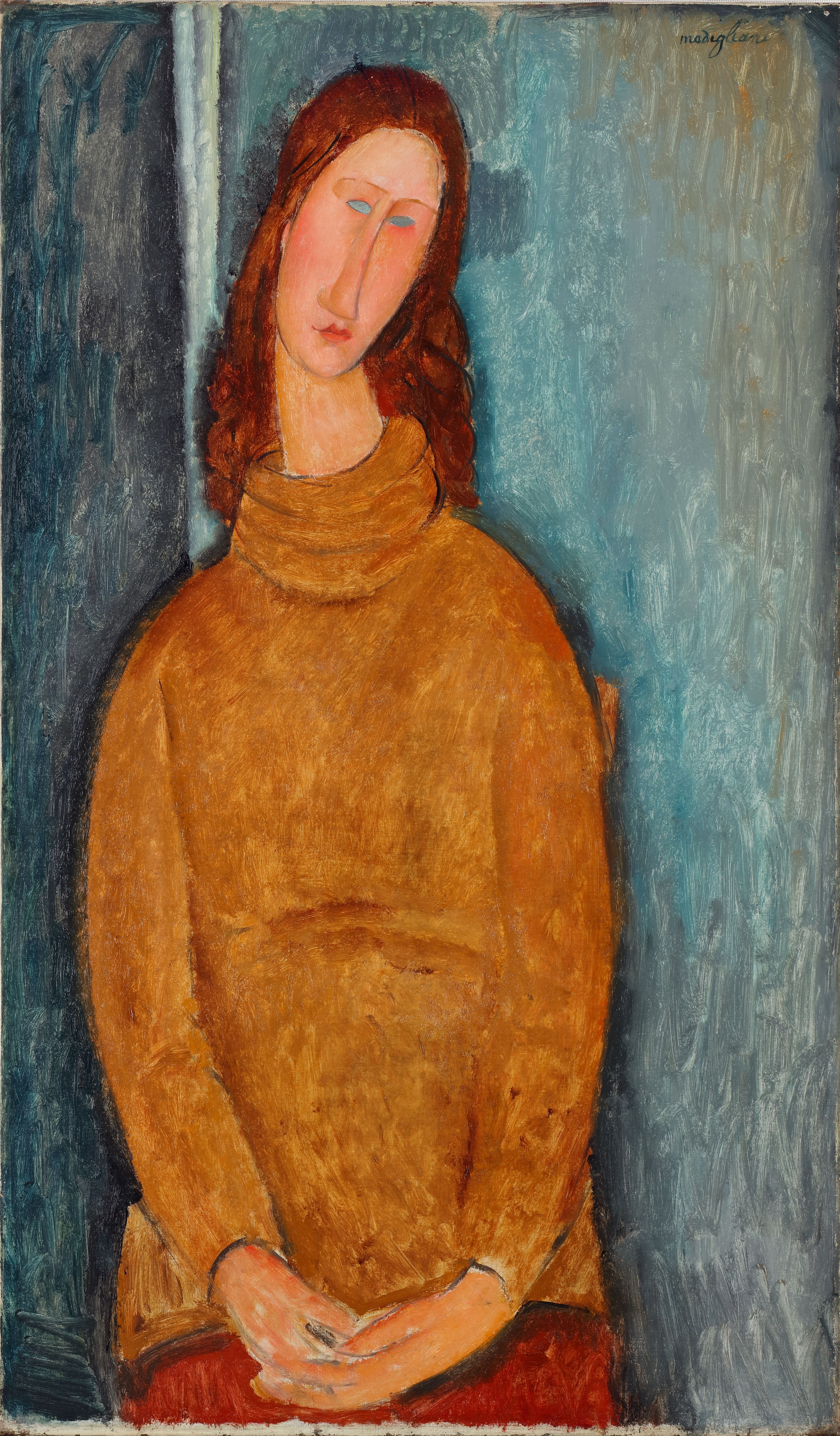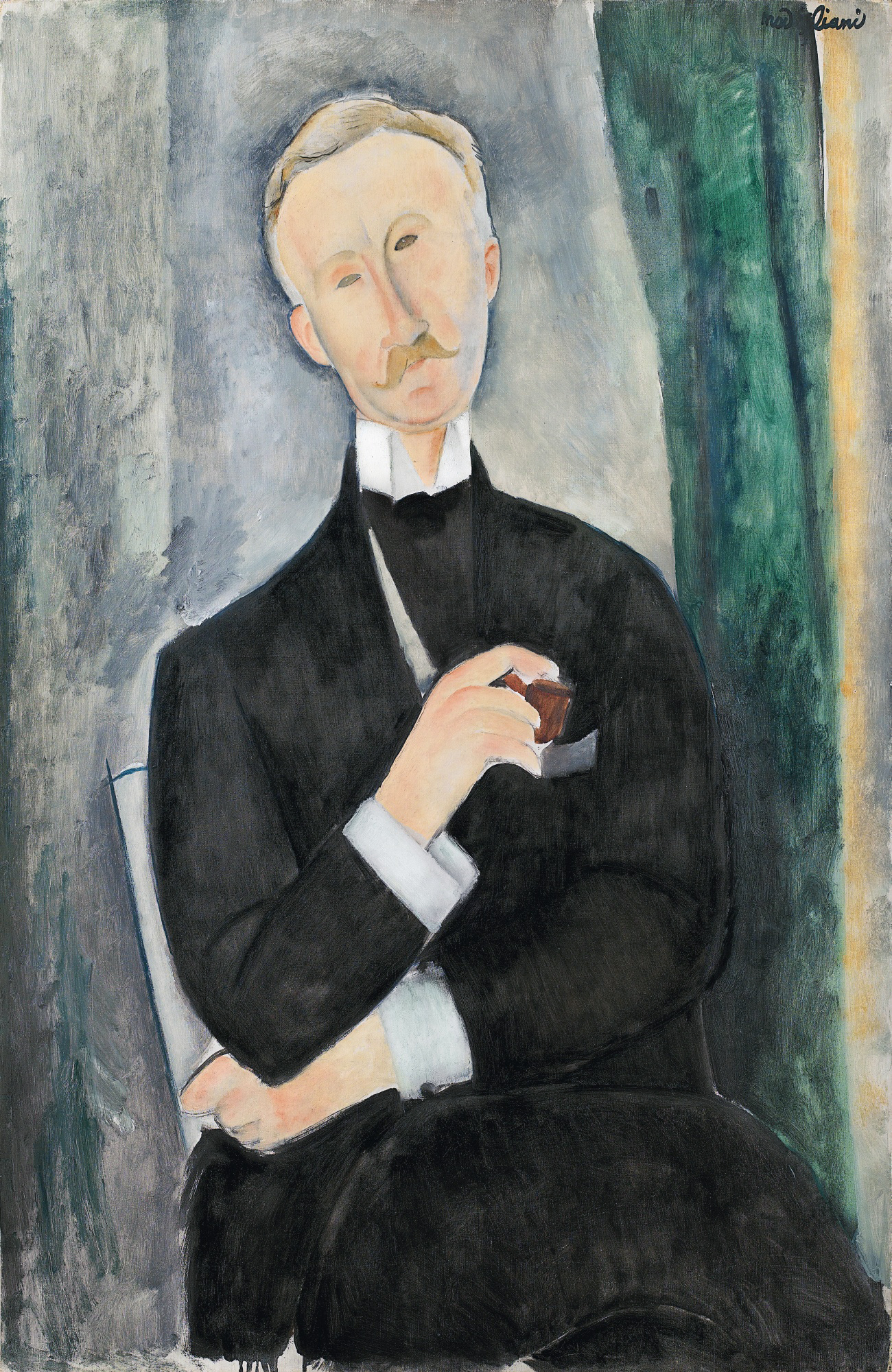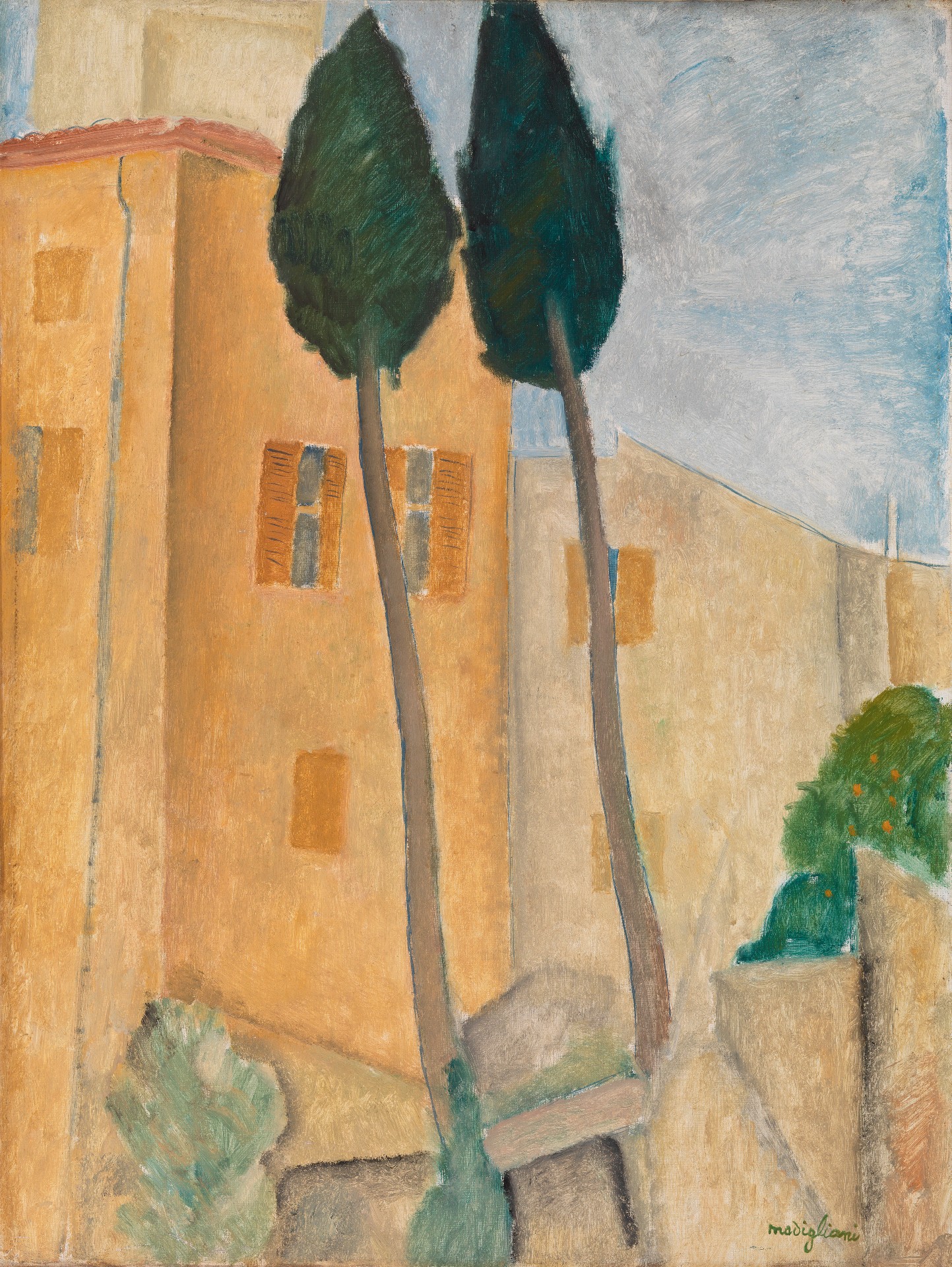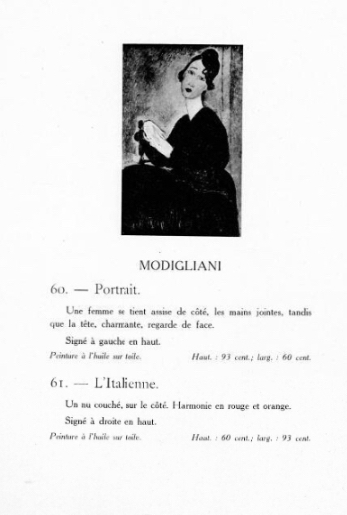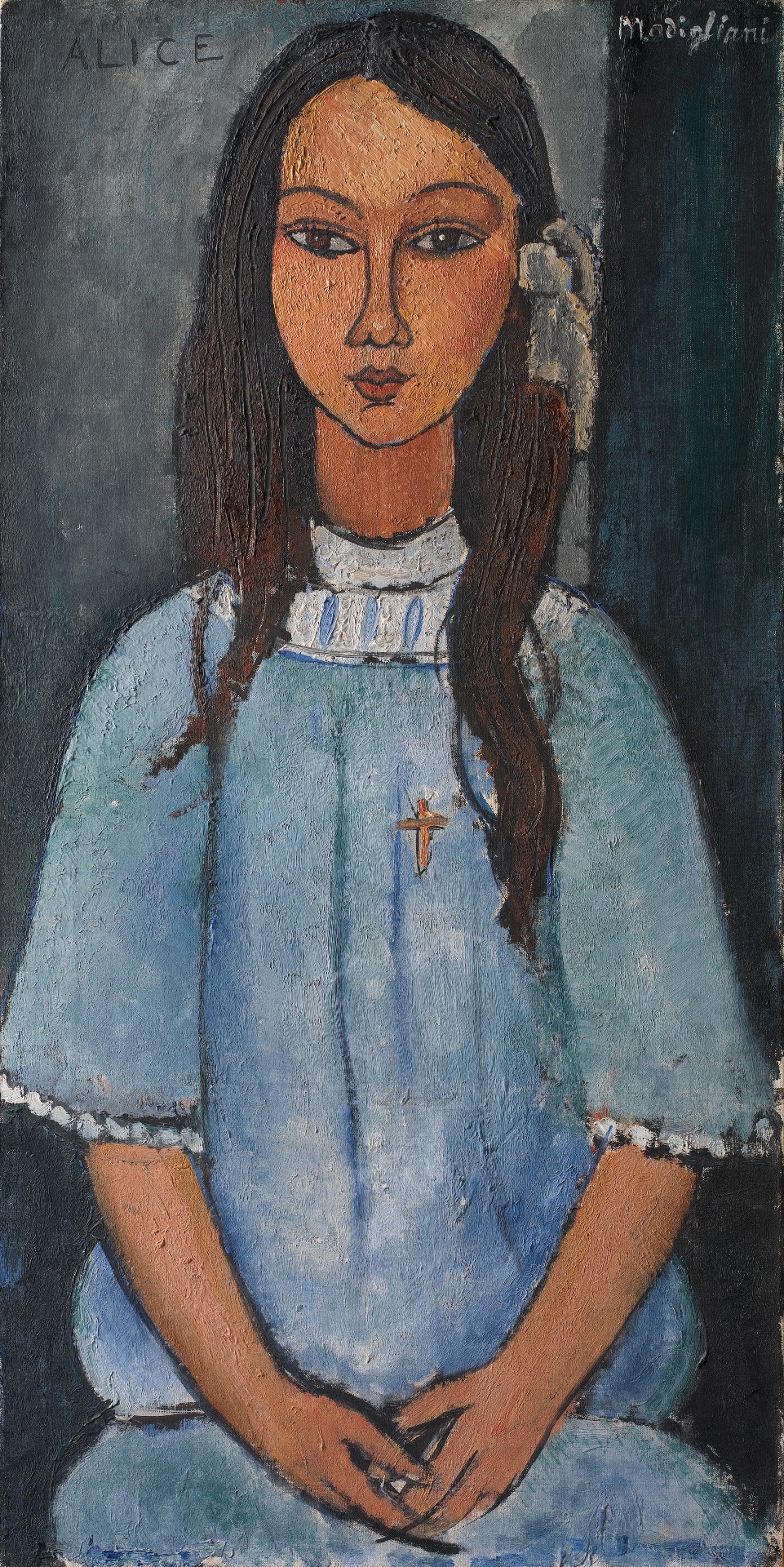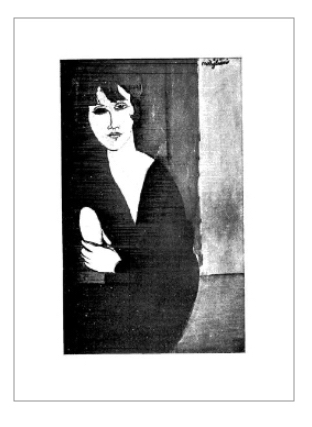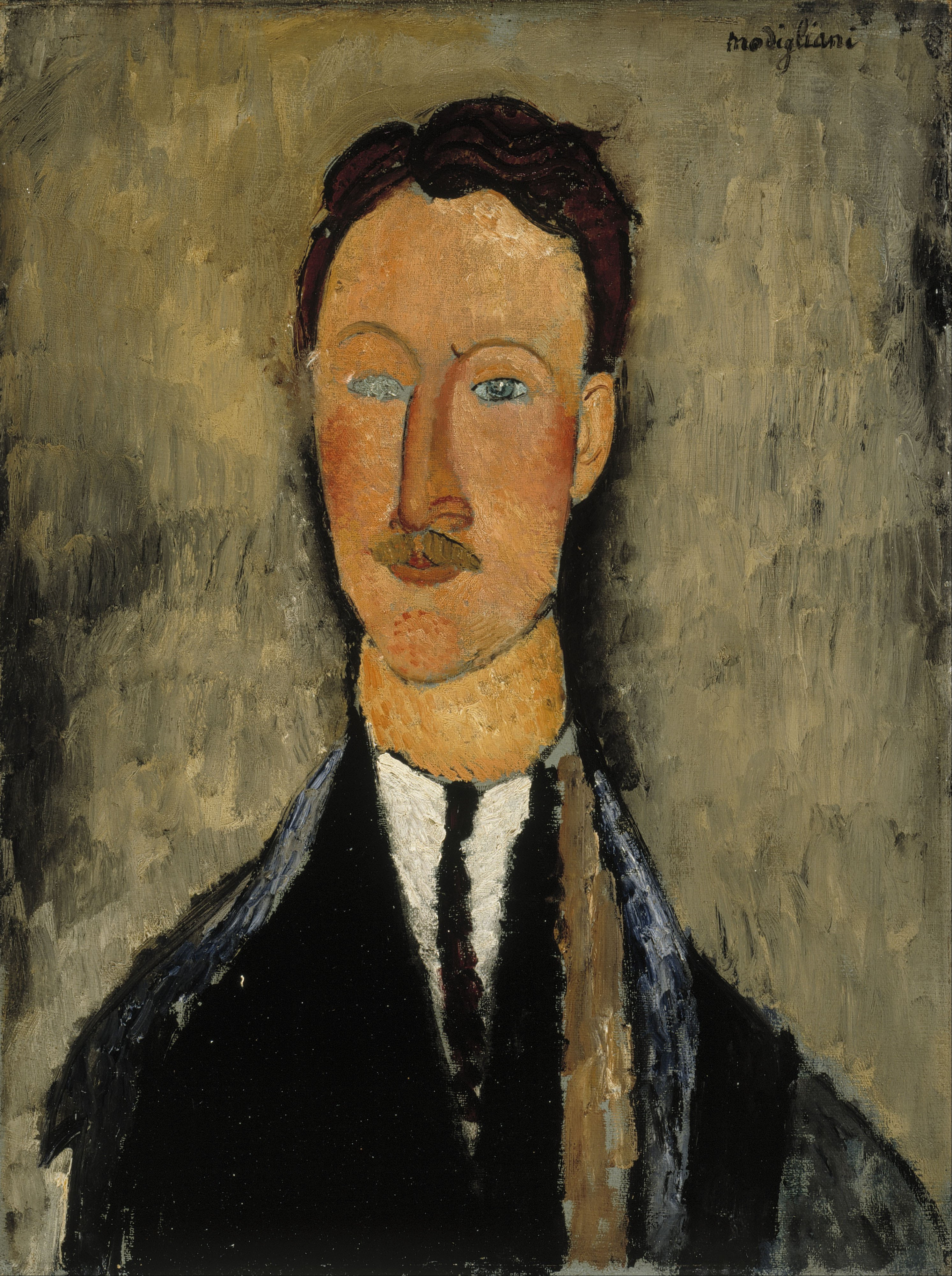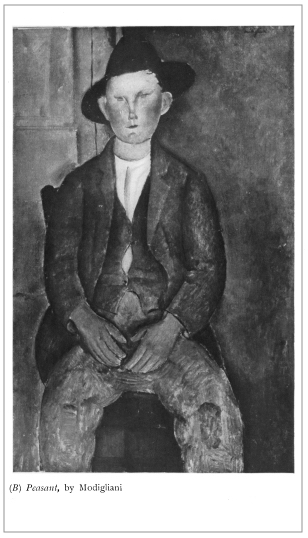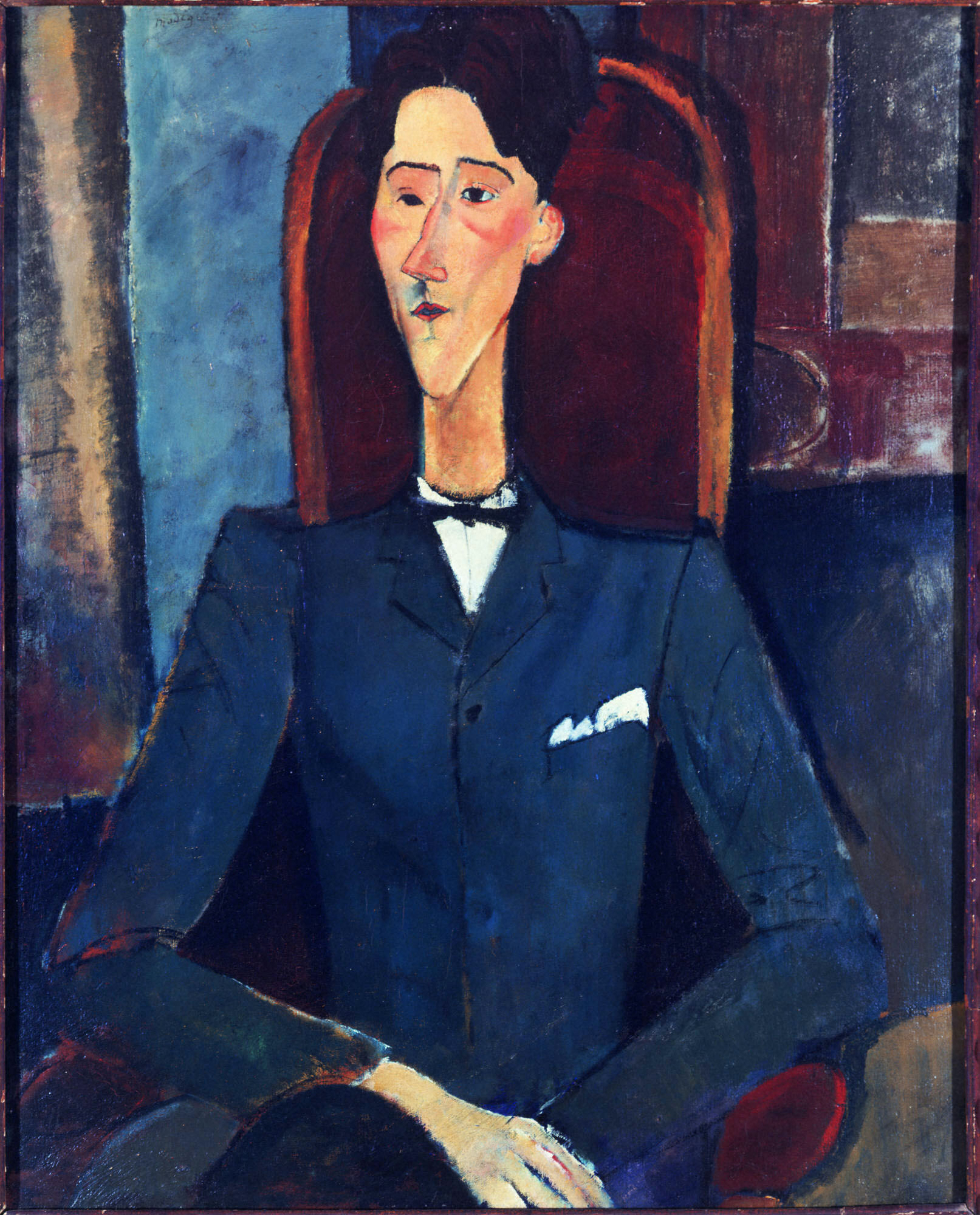Biographical Timeline
“Amedeo Clemente Modigliani is born to Eugenia Garsin Modigliani (1855–1927) and Flaminio Modigliani (1840–1928), both Sephardic Jews. Nicknamed “Dedo,” he has three older siblings: Emanuele (1872–1947), Margherita (1874–1950), and Umberto (1878–?). Flaminio and his two brothers run successful mines in Sardinia which keeps him away from his wife and children for most of the year. Shortly before Amedeo’s birth, the mining business fails and Flaminio declares bankruptcy. The family is forced to give up their grand home on Via Roma in Livorno (Leghorn), the Mediterranean port city on the west coast of Tuscany.
Modigliani residence, Via Roma 38, Livorno
Courtesy of Julie Martin
”
1884, July 12
“Isaac Garsin (1819–1894), Modigliani’s maternal grandfather who is a widower, moves in with the family. A cultured man with an active interest in the arts, Isaac looks after his young grandson and they develop an intimate bond.”
1886
“Ten-year-old Modigliani is deeply affected by the death of his beloved grandfather.”
1894
“Amédée Garsin (1860–1905), Eugenia’s generous brother, pays for his namesake’s drawing classes in the atelier of Guglielmo Micheli (1866–1926).”
1898, August 1
“Modigliani develops pleurisy, his first serious illness.”
1895, summer
“Invigorated by his art classes, Modigliani decides to leave school and spends every day at Micheli’s studio. His enthusiasm surprises and delights his mother. After he recovers from a bout with typhoid, Modigliani and Eugenia travel to Florence, where they visit the Uffizi and the Palazzo Pitti.
Eugenia Garsin Modigliani
Courtesy of Julie Martin
”
1899
“Modigliani contracts tuberculosis. To aid his convalescence, Eugenia accompanies him on a trip that begins in Torre del Greco, a seaside town south of Naples, where they stay for two months. After spending time in Capri and Amalfi, they travel to Rome, Florence, and Venice, and visit numerous museums, churches, and galleries. This grand tour of the country’s cultural centers convinces Modigliani that he needs to continue his artistic training in one of these renowned art centers.”
1900, September
“Again, with the financial support of his uncle Amédée, Modigliani begins his independent life away from home and begins taking art classes at the Scuola Libera del Nudo in Florence.
Amedeo Modigliani, c. 1901
Courtesy of Julie Martin
”
1901, May
“Modigliani decides to dedicate himself to sculpture and convinces his mother to lend him money to go to Carrara, the center of marble quarries. He settles in Pietrasanta and takes lessons in the studio of Emilio Puliti (dates unknown). He completes a sculpture in marble, a material he learns is tiresome to use.”
1902
“Modigliani moves to Venice, where he enrolls in classes at the Accademia di Belle Arti. He meets Manuel Ortiz de Zárate (1887–1946), a Chilean artist, who shares stories of his time with fellow artists in Paris, inspiring Modigliani to want to live there. Ortiz de Zárate confirms that at this point Modigliani is determined to become a sculptor.”
1903, May
“The death of his uncle, Amédée, likely means that the artist receives enough of an inheritance to pay for his move to Paris where he plans to launch his career.”
1905, February
“Modigliani arrives in Paris. While staying at a hotel near La Madeleine, he attends classes at the Académie Colarossi where he has access to live models.”
1906, January
“Known as “Modi” to his friends, he begins frequenting Chez Rosalie, the recently opened restaurant on rue Campagne-Première in Montparnasse. Run by Rosalie Tobia (c. 1865–1933), a fellow Italian who had been an artist’s model, she has a soft spot for Modigliani and frequently accepts his drawings as payment for his meals.
Rosalie Tobia
Courtesy of Julie Martin”
1906
“The Salon d’Automne presents a major posthumous retrospective of the work of Paul Gauguin (1848–1903) whose paintings, drawings, and wood carvings on view are of great interest to Modigliani.”
1906, October 6–November 15
“Three small canvases by Modigliani hang in the window of Laura Wylda’s gallery in rue des Saints-Pères; none are sold.
Modigliani, c. 1906”
1906, December
“He takes a studio at 7 place Jean-Baptiste-Clément in Montmartre.
”
1906, early winter
“The artist exhibits two oils and five watercolors at the Salon d’Automne which also features the first major retrospective of Paul Cézanne (1839–1906) exactly a year after his death. Modigliani is deeply influenced by Cézanne’s paintings.
”
1907, October 1–22
“Modigliani meets Dr. Paul Alexandre (1881–1968), a dermatologist who recently began renting from the city a condemned, two-story house at 7 rue de Delta in Montparnasse that he has turned into an artists’ colony. Alexandre is Modigliani’s first patron and commissions several portraits of himself and his family members. By 1914, Alexandre owns twenty-five paintings and around 450 drawings by the artist.
Portrait of Paul Alexandre, c. 1909
Black fabricated chalk on cream wove paper, 7 4/5 x 10 3/5 in. (20 x 27 cm.)
Gift of Dorothy Braude Edinburg to the Harry B. and Bessie K. Braude Memorial Collection, Art Institute of Chicago (2013.982)”
1907, November
“At the Salon des Indépendants, Modigliani exhibits one drawing and five paintings, including Portrait [The Jewess].
The Jewess, c. 1907–1908
Oil on canvas, 21 5/8 x 18 1/8 in. (54.9 x 46 cm)
Private collection”
1908, March 20–May 2
“He moves to Montparnasse where a new group of mostly emigré artists is emerging, centered around La Ruche (“the beehive”)—named for its hive-like shape—the artists’ studios that opened in 1902. Modigliani stays at the Hôtel du Poirier or with friends and socializes at the cafés La Rotonde, Le Dôme, and La Closerie des Lilas.
La Ruche, the artists’ studios and residence
Courtesy of Julie Martin”
1909
“Through Alexandre, Modigliani meets the sculptor Constantin Brancusi (1876–1957). He starts a portrait of Brancusi but abandons the painting and instead uses the reverse for a study for The Cellist.
Study for a Portrait of Constantin Brancusi, 1909
Oil on canvas, 29 1/8 x 23 5/8 in. (74 x 60 cm)
Private collection
(This is the reverse of Étude pour “Le Violoncelliste”)”
Early 1909
“He attends the first solo exhibition of the Polish-born sculptor Elie Nadelman (1882–1946) at the Galerie Druet. The combination of meeting Brancusi, attending Nadelman’s exhibition, and discovering African sculpture—all around the same time—becomes the catalyst for Modigliani to abandon painting and begin working as a sculptor. He takes a studio at 14 Cité Falguière where Brancusi also works.”
1909, April
“He travels to Livorno for the first time in three years and has a productive summer before returning to Paris in late September.”
1909, late June or early July
“Modigliani meets and begins a relationship with the married Russian poet Anna Akhmatova (1889–1966) who inspires the artist to draw numerous sketches of her. Many are bought by Paul Alexandre. Others, owned by Akhmatova, are reportedly lost in a fire at her home in Russia years later.”
1910–1911
“The artist exhibits six paintings, including The Cellist, 1909, in the Salon des Indépendants. Reviews of the exhibition by the art critics André Salmon (1881–1969) and Guillaume Apollinaire (1880–1918) mention Modigliani by name although they offer no details about his works.
”
1910, March 18–May 1
“He shows sculptures at the rue de Colonel Combes studio of his friend, the painter Amadeo de Souza Cardoso (1887–1918).”
1911, March
“Modigliani’s friend, the poet Max Jacob (1876–1944), introduces him to the sculptor Jacques Lipchitz (1891–1973).”
1911, spring–summer
“Though focused on sculpture, Modigliani creates a series of Caryatid paintings, drawings, and watercolors.
Cariatide, 1911–13
Oil on canvas mounted on panel, 34 7/16 x 26 3/8 in. (87.5 x 67 cm)
Aichi Prefectural Museum of Art”
1911–1913
“In the Salon d’Automne, he exhibits Tête, ensemble décoratif, a collection of seven sculptures. After the show closes, Edward Roworth (1880–1964), a South African-born artist who is studying in London and visits Paris as a newlywed, meets Modigliani and acquires one of these sculptures for £5.
Cubist Room, Salon d’Automne, 1911
Head, c. 1911–12 (two views),
Stone, H: 28 3/4 in. (73 cm)
Private collection
Courtesy of Julie Martin”
1912, October 1–November 8
“The U.S.-born British sculptor, Jacob Epstein (1880–1959), a friend of Modigliani’s, introduces him to Augustus John (1878–1961), the Welsh painter who is visiting Paris from London. John comes to Modigliani’s studio, at 216 Boulevard Raspail, and buys two stone heads, giving Modigliani enough money to return to Italy for an extended stay that spring. Before leaving, however, he falls ill and is briefly hospitalized in Paris.”
1913, early spring
“The artist recuperates with his family in Livorno.”
1913, April–June
“Through Lipchitz, he meets the painter Chaïm Soutine (1893–1943) who becomes a close friend. Modigliani paints four portraits of him.
Chaim Soutine, 1917
Oil on canvas, 36 1/8 x 23 1/2 in. (91.7 x 59.7 cm)
Chester Dale Collection, Courtesy National Gallery of Art, Washington, D.C. (1963.10.47)”
1914
“Back in Paris, Modigliani lives briefly with the painter Diego Rivera (1886–1957) in his studio at 26 rue du Départ before moving on his own to 16 rue de Saint-Gothard. At Rosalie’s, he meets the Welsh painter Nina Hamnett (1890–1956) who has recently arrived in Paris; she buys drawings from him and they share an affinity for portraiture.
”
1914, late winter–early spring
“Georges Chéron (?–1931), son-in-law of the art dealer Édouard Devambez (c. 1843–1923), supplies Modigliani with painting materials and a room to work in in the basement of his rue de la Boétie shop. Chéron pays him between 10 and 15 francs a day to produce paintings for him to sell. This arrangement is short-lived.”
1914
“Twentieth Century Art: A Review of Modern Movements, the exhibition at the Whitechapel Art Gallery, London, includes two of Modigliani’s stone heads. The artist’s loan is arranged with the help of Epstein, whose work is also shown. A review in The Jewish Chronicle, the London newspaper, calls Modigliani’s sculpture “Futurist,” clarifying this to mean that it is “beyond our comprehension.””
1914, May 8–June 20
“Modigliani spends much of his time at Café de la Rotonde, located on the corner of the boulevards Montparnasse and Raspail, where he draws portraits often on paper supplied by the café. He either sells these for a handful of francs or exchanges the drawings for food and drink.
The newly opened Café de la Rotonde at left, winter 1903–1904
Courtesy of Julie Martin”
1914
“Modigliani meets the English poet Emily Alice Haigh (1879–1943), whose pen name is Beatrice Hastings. During their two rather volatile years together, he paints at least fourteen portraits of Beatrice. She lives at 55 rue du Montparnasse, in relative comfort, which Modigliani certainly enjoys.
Beatrice, 1916
Oil on canvas with newsprint, 21 3/4 x 15 1/16 in. (55.2 x 38.2 cm)
The Barnes Foundation, Philadelphia (BF361)”
1914, July
“War is declared and artists and friends from Modigliani’s circle, including Paul Alexandre, Guillaume Apollinaire, and Blaise Cendrars (1887–1961), begin leaving for the front. Moïse Kisling (1891–1953) joins the French Foreign Legion and is badly wounded in 1916. Modigliani, who is unfit for service, remains in Paris. He completes portraits of his friends, the painters Diego Rivera and Frank Burty Haviland (1886–1971).
Reverie (Study for the Portrait of Frank Burty Haviland), 1914
Oil and graphite on cardboard, 24 1/2 x 19 1/2 in. (62.23 x 49.53 cm)
Los Angeles County Museum of Art, Mr. and Mrs. William Preston Harrison Collection (27.7.2a)”
1914, August 1
“Max Jacob introduces the artist to Paul Guillaume (1891–1934), the rising young dealer of contemporary art and African sculpture. Allegedly with Guillaume’s encouragement, and because stone is increasingly difficult to obtain and tiring to sculpt, Modigliani focuses once again to painting.”
Likely late 1914
“In need of subjects for his paintings, Modigliani turns to his circle of friends and associates who remain in Paris during the war: Juan Gris (1887–1927); Celso Lagar (1891–1966); Henri Laurens (1885–1954); Pablo Picasso (1881–1973); and André Rouveyre (1879–1962), among others. Guillaume begins acquiring Modigliani’s paintings and by 1916 he reportedly owns around twenty-five, most of which he puts aside at his home at 36 bis rue Jouffroy.”
1915
“Marie Vassilieff (1884–1957), a Russian painter, opens a canteen in her studio at 21 avenue de Maine, Montparnasse. In doing so, she provides artists with affordable meals and a place to gather.
Vassilieff Canteen, 1915, by Arvid Fougstedt (1888-1949),
Courtesy of Julie Martin”
1915, February
“Modigliani paints what is likely his first portrait of Paul Guillaume. Of the four portraits he completes of the art dealer, two are dated 1915 and two are dated 1916.
Paul Guillaume, 1915
Oil on cardboard, 29 1/2 x 20 11/16 in. (75 x 52.5 cm)
Toledo Museum of Art, Gift of Mrs. C. Lockhart McKelvy, 1951.382”
1915, September
“Guillaume rents Modigliani a studio in the “Bateau Lavoir,” the famed artists’ studios at 13 rue Ravignon (place Émile Goudeau), in Montmartre.”
1915, by November
“Chéron establishes the Galerie des Indepéndants (Chéron et Cie) at 56 rue de la Boétie.”
1915, December
“291, the magazine published in New York by Alfred Stieglitz (1864–1946), features Max Jacob’s essay, “La vie artistique,” which mentions Modigliani by name.”
1916, February
“Sculptures by Modigliani and Brancusi are shown at the Modern Gallery, 500 Fifth Avenue, New York, which is run by Marius de Zayas (1880–1961).”
1916, March 8–22
“The Swiss journal, Cabaret Voltaire, publishes Modigliani’s portrait drawing of the German sculptor Hans “Jean” Arp (1886–1966).”
1916, May 15
“Kisling introduces Modigliani to the poet Léopold Zborowski (1889–1932), who, like Kisling, is from Poland. Modigliani goes on to paint at least six portraits of Zborowski after they begin working together later in the year.
Léopold Zborowski, 1919
Oil on canvas, 21 5/8 x 15 1/16 in. (55 x 38.2 cm)
The Barnes Foundation, Philadelphia (BF261)”
1916, circa June
“After his stormy relationship with Hastings ends, Modigliani becomes romantically linked to one of her friends, a woman named Simone Thiroux (1893–1920). Thiroux gives birth to a son in September 1917 and claims that Modigliani is the father, although he refuses to accept that the child is his.”
1916
“L’Art Moderne en France, a ground-breaking group exhibition of over 150 paintings including three by Modigliani, is organized by André Salmon and sponsored by the designer and art collector Paul Poiret (1879–1944). The exhibition takes place at Poiret’s Salon d’Antin, located in the Galerie Barbazanges.”
1916, July 16–31
“The poet Jean Cocteau (1889–1963) photographs Modigliani with Max Jacob, André Salmon, and Ortiz de Zárate in Montparnasse.
From left: Modigliani, Max Jacob, André Salmon, Ortiz de Zarate. August 12, 1916.
Jean Cocteau Archive
Courtesy Julie Martin”
1916, August 12
“1ere Exposition: Kisling, Matisse, Modigliani, Ortiz de Zarate, Picasso: Sculptures nègres takes place at Lyre et Palette, a large studio space at 6 rue Huyghens. Émile Lejeune (1885–1964), a Swiss painter, is responsible for establishing the venue which offers performances and exhibitions. This exhibition features over a dozen Modigliani paintings all of which are loaned by Paul Guillaume and includes Madam Pompadour. Zborowski is impressed by the works and begins to represent Modigliani around this time.
Lyre et Palette Opening, 1916, by Arvid Fougstedt (1888–1949),
Courtesy Julie Martin
Madam Pompadour, 1915
Oil on canvas, 24 1/16 x 19 3/4 in. (61.1 x 50.2 cm)
Joseph Winterbotham Collection, Art Institute of Chicago (1938.217)”
1916, November 19–December 5
“Léopold Zborowski and Anna / Hanka Zborowska (1885–1978), whether they were actually married is unclear, move to an apartment at 3 rue Joseph Bara where their dining room becomes a studio for Modigliani. He also paints in the studio of Kisling who lives upstairs. Around the same time, Modigliani meets Lunia Czechowska (1894–1990), the wife of one of Zborowski’s childhood friends, who moves in with the couple after her husband leaves for the front. Lunia and Hanka become two of Modigliani’s most important models and he paints and draws their likenesses numerous times during the remainder of his life.
Madame Hanka Zborowska Leaning on a Chair, 1919
Oil on canvas, 36 1/4 x 21 3/8 in. (92.1 x 54.3 cm)
The Barnes Foundation, Philadelphia (BF375)
Portrait of Lunia Czechowska, 1917
Oil on canvas, 27 15/16 x 16 9/16 in. (71 x 42 cm)
Pola Museum of Art, Hakone, Japan”
Late 1916; by 1917
“Modigliani begins a series of nudes. Most of the approximately thirty-five canvases are completed during the winter of 1917 in the Zborowski apartment.
Reclining Nude from the Back, 1917
Oil on canvas, 25 1/2 x 39 1/4 in. (64.8 x 99.7 cm)
The Barnes Foundation, Philadelphia (BF576)”
1917
“After meeting Jeanne Hébuterne (1898–1920), an art student at Academie Colarossi, several months earlier, Modigliani and she become romantically involved.”
1917, March
“Chéron’s gallery presents a group show that includes Modigliani.”
1917, May 1–20
“Galerie Dada, Zurich, has a group show of drawings with examples by Modigliani.”
1917, May 4–29
“Zborowski rents a two-room apartment for Modigliani and Jeanne Hébuterne at 8 rue de la Grande Chaumière. Jeanne becomes his most important model and he paints her portrait over twenty-five times.
Portrait of Jeanne Hébuterne, 1919
Oil on canvas, 36 5/16 x 21 7/16 in. (92.3 x 54.5 cm)
Ohara Museum of Art, Kurashiki, Japan”
1917, July
“Galerie B. Weill, at 50 rue Taitbout, presents the artist’s only lifetime solo exhibition. Organized by Zborowski, the show includes thirty-two works, five of which are nudes. One of the nudes is visible from the street through the window and attracts a crowd outside the gallery, prompting the police to shut down the exhibition before it has officially begun. Only two drawings are sold so Berthe Weill (1865–1951), the gallery owner, buys five canvases herself.”
1917, December 3–30
“Roger Dutilleul (1873–1956), the French industrialist and contemporary art collector, begins buying Modigliani’s work and by 1925 he owns over thirty paintings. In 1919, he commissions a portrait from the artist.
Roger Dutilleul, 1919
Oil on canvas, 39 1/2 x 25 1/2 in. (100.4 x 64.7 cm)
Private collection”
1918, early spring
“After the Germans begin bombing Paris in March, and with Modigliani’s health declining, Zborowski decides to move him out of the city. He convinces Jonas Netter (1867–1946), an avid collector of Modigliani’s work, to fund the trip for the artist and his circle of friends: Hébuterne and her mother; the artist Tsuguharu Foujita (1886–1968) and his wife Fernande Barrey (1893–1960); Soutine, and the Zborowskis. The group travels to Cagnes-sur-Mer in southern France.”
1918, April
“When funds are depleted the group is forced to vacate their villa “Le Pavillon des Trois Soeurs.” They relocate to Nice where Modigliani finds a cheap room on the rue de France not far from the Zborowskis and Mme. Hébuterne and Jeanne. Here Modigliani paints portraits of the poet Blaise Cendrars; the pianist Germaine Meyer (m. Survage; dates unknown); the artist Léopold Survage (1879–1968); and the actor Gaston Modot (1887–1970) and his wife Renée (1894–1978). At Survage’s suggestion, Modigliani paints four landscapes but decides he prefers portraiture.
Portrait of Blaise Cendrars, 1918
Oil on cardboard, 24 x 19 11/16 in. (61 x 50 cm)
Private collection
Cypresses and Houses at Cagnes, 1919
Oil on canvas, 24 x 18 1/8 in. (61 x 46 cm)
The Barnes Foundation, Philadelphia (BF259)”
1918, July
“Modigliani becomes sick with the flu and is too weak to paint.”
1918, summer
“Zborowski departs for Marseille where he sells ten paintings to Netter for 500 francs. Netter goes on to build a collection of over sixty paintings by the artist.”
1918, late summer
“Modigliani celebrates Armistice Day in Nice with Survage.”
1918, November 11
“Birth of Jeanne, Modigliani’s daughter, in Nice.
Roma Woman with Baby, 1919
Oil on canvas, 45 5/8 x 28 3/4 in. (115.9 x 73 cm)
Chester Dale Collection, Courtesy National Gallery of Art, Washington, D.C. (1963.10.174)”
1918, November 29
“Galerie Paul Guillaume presents Exposition peintres d’aujourd’hui, an important group show that includes four paintings by Modigliani.
”
1918, December 15–23
“Publication of Blaise Cendrars’s Dix-neuf poèmes élastiques, a book that features two drawings by Modigliani of Cendrars.”
1919
“The collection of Eugène Descaves (1863–1934), a police commissioner and avid collector of contemporary art, is sold in Paris at the Hôtel Drouot. This is the first auction of Modigliani’s paintings to take place during his lifetime. His two paintings in the sale are: Portrait de Dédie, which is illustrated in the catalogue, and L’Italienne, a nude. Both are sold. Gustave Coquiot (1865–1926), the art critic and collector, writes the preface to the catalogue.
Portrait de Dédie, 1918
Centre Pompidou, Musée national d’art moderne, Paris (AM3974P)
As illustrated in Tableaux, aquarelles, pastels, dessins: Collection Eugène Descaves, Hôtel Drouot, Paris, March 28, 1919, lot 60 as Portrait.
”
1919, March 28
“Galerie Branger, 5 rue Cambon, shows the paintings of Modigliani and his friends: Maurice Utrillo (1883–1955) and the Polish painter Edouard Bara (Pierre-Édouard Baranowski; dates unknown). Modigliani paints the latter’s portrait around 1918.”
1919, April 12–30
“Galerie Ballu, 15 bis rue Ballu, presents a group show that includes Modigliani along with Kisling and Utrillo.”
1919, May
“The sale of the collection of the Danish architect Thorkild Henningsen (1884–1931) takes place at Dansk Kunsthandel, an auction house in Copenhagen, and includes three Modigliani paintings: Portrait of a Poet, Portrait of Zborowski, and Portrait of Alice. To date, only the latter has been identified.
Alice, 1917
Oil on canvas, 30 7/8 x 15 3/8 in. (78.5 x 39 cm)
Statens Museum for Kunst, Copenhagen (KMSr145)”
1919, May 20
“Modigliani departs Nice and returns to Paris.”
1919, May 31
“Back at the apartment on rue de la Grande Chaumière, Modigliani is alone because Jeanne has decided to stay in Nice with the baby for a while longer. Zborowski asks Lunia Czechowska to chaperone him and she sits for a number of portraits.”
1919, June
“Jeanne returns to Paris and is pregnant with the couple’s second child.”
1919, June 28
“L’Eventail: Revue de Littérature & d’Art, a journal published in Geneva, features a six-page article on Modigliani written by the art critic Francis Carco (1886–1958). The article is illustrated with three reproductions, including one of Le modèle, a painting in Carco’s collection.
Le modèle, 1916
Oil on canvas, 31 7/8 x 19 11/16 in. (81 x 50 cm)
As illustrated in L’Éventail: Revue de Littérature & d’Art II, no. 6 (July 15, 1919): 203.”
1919, July 15
“The Mansard Gallery at Heal & Son, a department store on Tottenham Court Road, London, presents Exhibition of French Art. The group show is organized by the Sitwell brothers, Osbert (1892–1969) and Sacheverell (1897–1988), who enlisted Zborowski to gather the artwork in Paris. On view are nine Modigliani paintings, including Portrait of Survage and The Little Peasant, which is reproduced in The Burlington Magazine in September.
Portrait of Léopold Survage, 1918
Oil on canvas, 24 3/16 x 18 1/8 in. (61.5 x 46 cm)
Ateneum Art Museum, Helsinki, Finland (A IV 2971)
The Little Peasant, c. 1918
Oil on canvas, 39 3/8 x 25 3/8 in. (100 x 64.5 cm)
Tate, London (N05269)
As illustrated in The Burlington Magazine for Connoisseurs 35, no. 198 (September 1919): 121.”
1919, August 9–September 6
“Modigliani is briefly hospitalized with the flu in Paris. Still in London for the exhibition, Zborowski receives a telegram asking that he refrain from selling any of the artist’s works. The implication is that if the artist dies, his paintings will be worth more.”
1919, August
“Apparently desperate to raise money for Modigliani, Zborowski offers to sell Sacheverell Sitwell what must have been his entire holdings of the artist’s work: “twelve large nudes, sixty to eighty paintings, and many sculptures and drawings” for between £700 and £1,000. Unable to convince his conservative father, Sir George Sitwell (1860–1943), to loan him the money, Sacheverell is forced to pass on the deal.”
1919, fall
“The Salon d’Automne resumes after a five-year hiatus because of the war and includes four Modigliani paintings.”
1919, November 1–December 12
“Modigliani draws and paints a portrait of Thora Dardel (1899–1995), a Swedish artist and writer who recently arrived in Paris. Dardel is accompanied to her sittings by her friend Annie Bjarne (dates unknown) and several days later the artist draws and paints Bjarne as well.”
1919, November 11
“Zborowski returns to London with a collection of Modigliani’s canvases that he has unstretched in order to save money on transportation. He rents a small room on Shaftesbury Avenue in the West End and writes to collectors, inviting them to see the paintings which he displays laid out on the floor. Hugh Blaker (1873–1936), an English artist and collector, buys four, including The Little Peasant. Zborowski is reportedly so relieved to have made a sale that he weeps with joy.”
1919, after mid-November
“After Modigliani’s health rapidly declines, he is admitted to the Hôpital de la Charité.”
1920, January 22
“He dies from tubercular meningitis.”
1920, January 24
“Jeanne Hébuterne, now well into her pregnancy, jumps to her death from a fifth-floor window in her parents’ home.
”
1920, January 25
“Friends of the artist form a procession as Modigliani’s body is transported from the hospital to Père Lachaise cemetery for his funeral.”
1920, January 27
“Exposition de Peinture Moderne opens on the day of the funeral at Galerie Devambez, 43 Boulevard Malesherbes. The show is organized by Paul Guillaume and features twelve Modigliani paintings from the dealer’s collection, including Jean Cocteau.
Jean Cocteau, 1916
Oil on canvas, 39 1/2 x 32 in. (100.4 x 81.3 cm)
The Henry and Rose Pearlman Foundation on loan since 1976 to the Princeton University Art Museum (L.1988.62.18)”
1920, January 27–February 12
“New Art Salon, a recently opened gallery located at 160 Shaftesbury Avenue, London, presents a group exhibition of modern French art; many of the paintings were reported to have been shown at the Mansard Gallery several months earlier. Subsequent exhibitions at the New Art Salon in February and April include works by Modigliani.”
1920, late January
“Five auctions take place in Paris at the Hôtel Drouot, offering at least eleven Modigliani paintings and a number of his drawings. Included in the five are single-owner sales of the collectors Louis Libaude (1896–1922), Léon Zamaron (1872–1955), and Georges Aubry (dates unknown).”
1920, March–December
“La Jeune Peinture Française takes place at Galerie Manzi-Joyant. The exhibition includes a Modigliani retrospective which is comprised of fifteen paintings, thirteen drawings, and three sculptures.”
1920, June 17–July 4
“A second Modigliani retrospective organized by Zborowski takes place at Galerie Montaigne with seventeen paintings and fifteen drawings.”
1920, December 11–29
In the months and years after Amedeo Modigliani’s death, prices for his canvases rose quickly. Dealers rushed to join the market and before long questionable works began to appear in auctions and exhibitions. The artist’s legacy was complicated not only by the chaotic nature of his short life but also by the suicide of Jeanne Hébuterne, who might have played a role in organizing his estate had she lived. In addition, both of his principal dealers—Léopold Zborowski and Paul Guillaume—died prematurely (in 1932 and 1934, respectively), leaving a dearth of documentation on the artist’s oeuvre.
A century later, disagreements about the authorship of some of the works attributed to Modigliani have, to an extent, overshadowed the need for a thorough academic reevaluation of the life and work of the artist. The Modigliani Initiative was founded to support the artist’s legacy by taking a fact-based and collaborative approach to documenting the artist’s oeuvre and recapturing the stories of the many characters in his artistic circle who inspired his portraits and nudes.
The information in this chronology of Modigliani’s life and activities comes largely from Meryle Secrest, Modigliani: A Life (2011). Secrest’s meticulous research derives in part from details collected by Julie Martin and Billy Klüver for their book, Kiki's Paris: Artists and Lovers, 1900-1930 (1989), and Pierre Sichel’s biography of the artist (1967). Both of these ground-breaking sources relied heavily on interviews with individuals who offered first-hand accounts of the events and people that Secrest describes. The chronology is supplemented with original research by The Modigliani Initiative.
Selected Bibliography:
Kathleen Brunner, “Biographies of Modigliani’s Models,” in Modigliani and His Models exh. cat. (London: Royal Academy of Arts, 2006), 148–153.
Kathleen Brunner, “Chronology,” in Modigliani and His Models exh. cat. (London: Royal Academy of Arts, 2006), 142–147.
Charles Douglas, Artist Quarter: Modigliani, Montmartre & Montparnasse (London: Pallas Athene, 2019; reprint of 1941 publication by Douglas Goldring and Charles Beadle)
Malcolm Gee, Dealers, Critics, and Collectors of Modern Painting: Aspects of the Parisian Art Market Between 1910 and 1930 (New York and London: Garland Publishing, Inc., 1981)
Billy Klüver and Julie Martin, Kiki's Paris: Artists and Lovers, 1900–1930 (New York: Harry N. Abrams, Inc., 1989)
Meryle Secrest, Modigliani: A Life (New York: Alfred A. Knopf, 2011)
Pierre Sichel, Modigliani: A Biography of Amedeo Modigliani (London: W.H. Allen, 1967)
